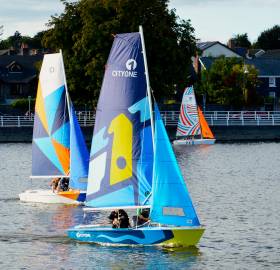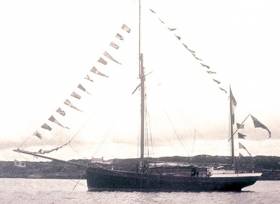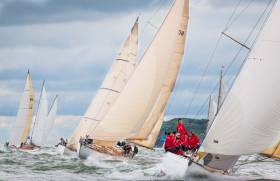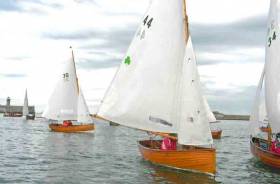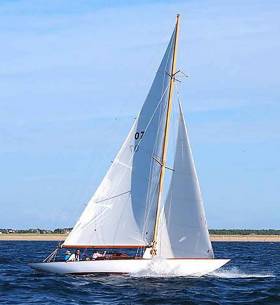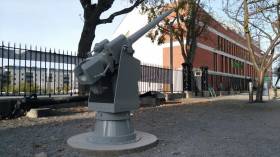Displaying items by tag: Historic Boats
2017 – A Very Irish Sailing Season
While sailing is now a year-round interest, and for many a year-round activity too, the notion of a traditional season is natural for anyone who lives in Ireland. Admittedly, there are times when we seem to be experiencing the four annual climatic seasons in just one day. But this sense of a seasonal change, and the appropriate alterations in activity which accompany it, are in our genetic makeup. And though marinas and the Autumn Leagues which they facilitate have pushed the season’s end back to the October Bank Holiday Weekend, for many, that’s it. It’s finally time for boats to be rested and energies deployed in other ways. W M Nixon reflects on highlights of the year.
These times we live in, they tend to emphasise big events – celebrity happenings you might call them – and our perceptions of a season past may be skewed by how the major fixtures played through. But your true Irish sailing season has at its core the classic club programme from April to October, with its plethora of weekend and weekday evening events. If you want to sense the beating heart of our sailing, you have to take the pulse of this local and club scene.
We know it’s not for everyone. Some dinghy crews only emerge for major regional and national championships. But week in, week out, it’s the regular local sailing, from the smallest club right up to the majestic programme of Dublin Bay Sailing Club, which sets the tone for the majority of sailors.
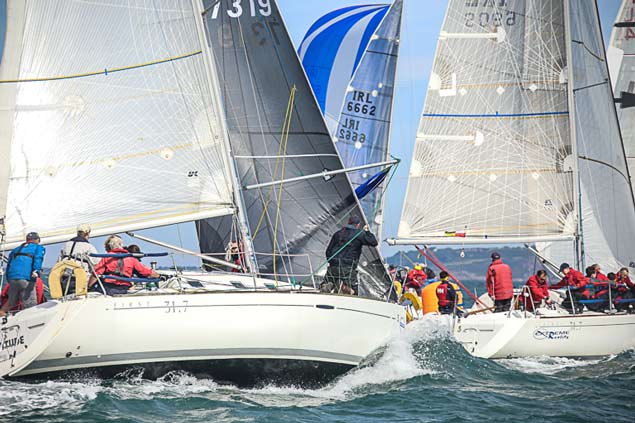 Week in, week out, Dublin Bay Sailing Club provides a comprehensive programme of local racing from the end of April until the end of September, and it has been successfully doing so since 1884. Here the club's Beneteau 31.7s, one of DBSC's largest one design keelboat fleets negotiate a weather mark at the class championships Photo David O’Brien/Afloat
Week in, week out, Dublin Bay Sailing Club provides a comprehensive programme of local racing from the end of April until the end of September, and it has been successfully doing so since 1884. Here the club's Beneteau 31.7s, one of DBSC's largest one design keelboat fleets negotiate a weather mark at the class championships Photo David O’Brien/Afloat
And for those who sailed regularly all through the time-honoured season, it has to be admitted that weatherwise, we experienced a very mixed bag. As we shall see, there were brief periods of good weather which blessed some events. But in any case, one dyed-in-the-wool cub sailor firmly told us that as far as he was concerned, it was a very good season.
“For sure, there was rain and wind,” he said. “But we need wind for sailing. If you get a long period of rain-free weather, the evenings are likely to be wind-free as well. Frankly I’d rather get a good race in rain than sit becalmed on a perfect summer’s evening. But as we’re an east coast club, we often get that east coast effect of Atlantic weather without Atlantic rain, which is ideal for club racing. By and large, it has been a good sailing season, and race management seems to be improving all the time. So 2017 is going to go down as a good year for club sailing, but only a very average year for sunshine”.
As for Irish sailing’s national structure, inevitably there’s a clashing of events. There is only a finite number of weekends available at peak season when different big ticket regattas and championships hope to be staged, but as well, each club and area quite rightly expect to bring prestigious fleets to its part of Ireland.
However, in 2017 there was increasing emphasis at official club level on making sailing fun again. We’d begun to take it too seriously, something reinforced by the grim years of the recession, and then the winning in 2016 of Annalise Murphy’s Silver Medal at the Olympics in Rio.
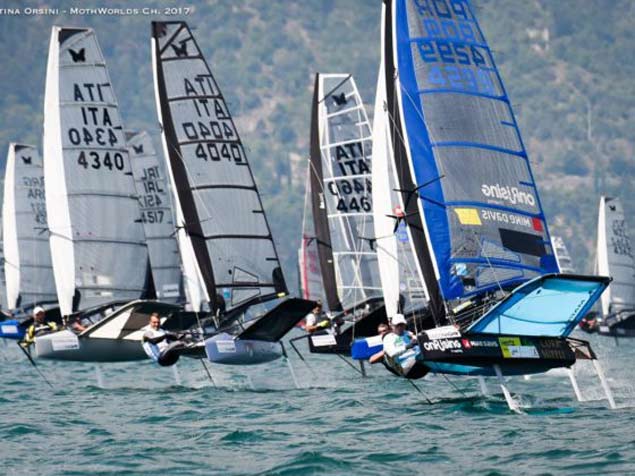 Olympic Silver Medallist Annalise Murphy led the way in signalling a change of mood for 2017 after the seriousness of her 2016 campaign towards success in Rio. In the early part of the season, she concentrated on the International Foiling Moth, and in this 223-strong fleet at the Worlds on Lake Garda in May, she became the Women’s World Champion. She is currently on a completely different direction for ten months on the Volvo Ocean Race as a crewmember on the One-Design Volvo Ocean 65 Turn the Tide on Plastic
Olympic Silver Medallist Annalise Murphy led the way in signalling a change of mood for 2017 after the seriousness of her 2016 campaign towards success in Rio. In the early part of the season, she concentrated on the International Foiling Moth, and in this 223-strong fleet at the Worlds on Lake Garda in May, she became the Women’s World Champion. She is currently on a completely different direction for ten months on the Volvo Ocean Race as a crewmember on the One-Design Volvo Ocean 65 Turn the Tide on Plastic
Of course the winning of Annalise’s medal was a matter for fun-filled celebration once it had happened, but the buildup to it was deadly serious, and that affected the tone of the national sailing mood in every area. But with the Medal in the bag, 2017 could reasonably expect to have a lighter mood, and this in turn helped us to adjust to an over-crowded programme, as crews could plan on a series of campaigns which balanced between serious events which provided proper championship results of national significance, and events which officially claimed to be providing everyone with a good time, even if some crews raced with deadly seriousness.
Either way, so much was going on that a review like this can only hope to give an impression of the season rather than a detailed analysis, but we’ll try to give it a comprehensible shape by listing the main events of Irish interest at home and abroad under either the “serious” or “fun” categorisations:
March/April: Intervarsity Championships – serious, UCD selected to represent Ireland
April: Irish Sailing Youth Pathway Nationals, Ballyholme - serious (and impressive), Ewan McMahon the star, Rush SC prominent in success
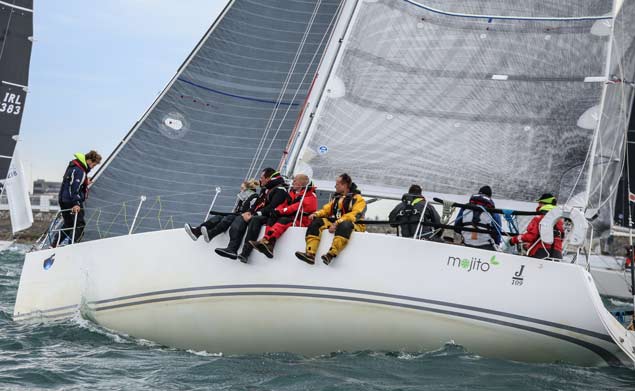 The hyper-busy J/109 Mojito managed a hard-fought overall win in the ISORA Championship, successful participation in the Rolex Rastnet Race, and a second place in the Dun Laoghaire to Dingle Race.
The hyper-busy J/109 Mojito managed a hard-fought overall win in the ISORA Championship, successful participation in the Rolex Rastnet Race, and a second place in the Dun Laoghaire to Dingle Race.
April: Season-long ISORA Championship get under way, several venues – inevitably serious. In due course, J/109 Mojito (Peter Dunlop & Vicky Cox, Pwllheli SC) has very close overall win – despite taking time out to do the Fastnet
May: Scottish Series at Tarbert– serious, Pat Kelly’s J/109 Storm and Stephen Quinn’s J/97 Lambay Rules top their classes.
June: Howth Lambay Weekend – Fun
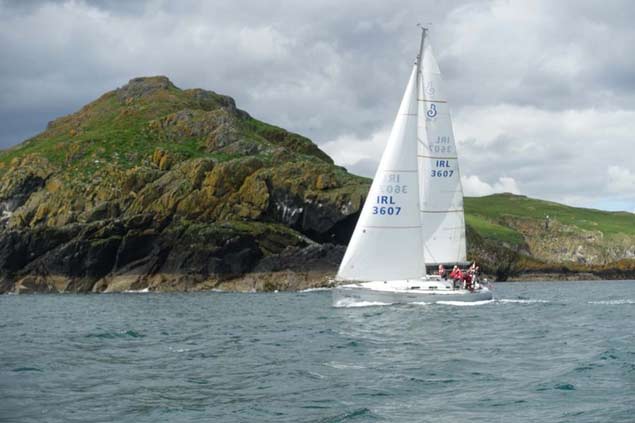 It could be a remote part of the West Coast, but Howth Yacht Club’s annual Lambay Race is a reminder that Ireland’s least-spoilt coastline is on an East Coast island. Photo courtesy HYC
It could be a remote part of the West Coast, but Howth Yacht Club’s annual Lambay Race is a reminder that Ireland’s least-spoilt coastline is on an East Coast island. Photo courtesy HYC
June: ICRA Nationals Royal Cork – probably the most serious of them all. John Maybury’s J/109 Joker 2 RIYC), Ross MacDonald’s X332 Equinox (HYC), and Paul Gibbons’ Anchor Challenge (RCYC) win the three main classes.
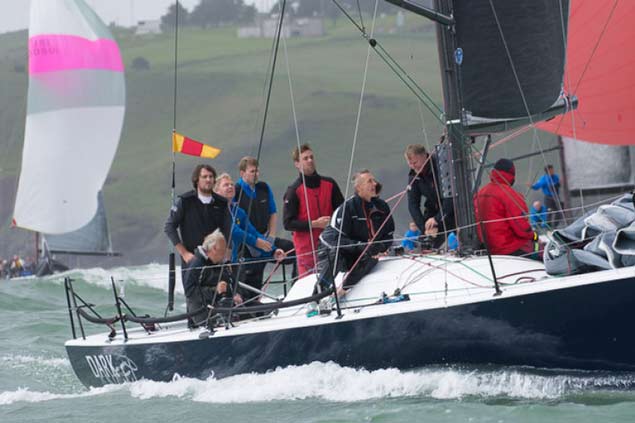 Rob O’Leary racing the Dubois 36 Dark Angel from South Wales to class success in the ICRA Nats at Crosshaven. Photo: Robert Bateman
Rob O’Leary racing the Dubois 36 Dark Angel from South Wales to class success in the ICRA Nats at Crosshaven. Photo: Robert Bateman
 Paul O’Higgins’ JPK 10.80 Rockabill VI shortly after the start of the very tough Dun Laoghaire to Dingle Race, which she won, while a sister-ship Bogatyr was also winner of the likewise rough 608-mile Rolex Middle Sea Race in late October. This photo goes some way to revealing the reason for the JPK 10.80’s success – she is only 35ft LOA, yet you’d think you’re looking at a significantly larger boat. Photo: David O’Brien/Afloat.ie
Paul O’Higgins’ JPK 10.80 Rockabill VI shortly after the start of the very tough Dun Laoghaire to Dingle Race, which she won, while a sister-ship Bogatyr was also winner of the likewise rough 608-mile Rolex Middle Sea Race in late October. This photo goes some way to revealing the reason for the JPK 10.80’s success – she is only 35ft LOA, yet you’d think you’re looking at a significantly larger boat. Photo: David O’Brien/Afloat.ie
June: National YC Volvo Dun Laoghaire to Dingle Race – serious
June: Sovereign’s Cup at Kinsale – fun
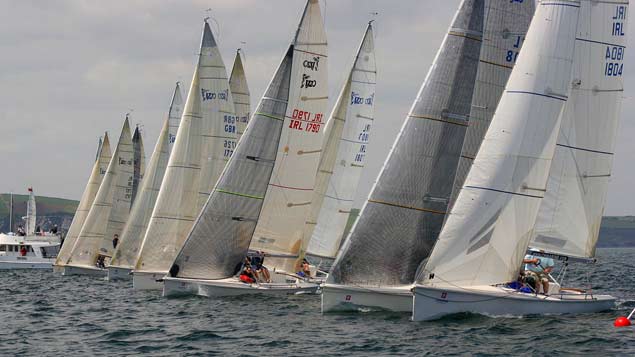 By maintaining its position as a standalone event, the Sovereign’s Cup at Kinsale can invite non-IRC classes to compete, and the 1720s responded with this keen turnout. The overall winner across all classes was adjudged to be Rob McConnell’s A35 Fool’s Gold from Dunmore East. Photo: Robert Bateman
By maintaining its position as a standalone event, the Sovereign’s Cup at Kinsale can invite non-IRC classes to compete, and the 1720s responded with this keen turnout. The overall winner across all classes was adjudged to be Rob McConnell’s A35 Fool’s Gold from Dunmore East. Photo: Robert Bateman
June: Dinghyfest at Royal Cork – brilliantly balanced mixture of serious & fun
July: Volvo Dun Laoghaire Regatta – superb, and fun
July: WIORA Championship at Aran Islands – unique
 WIORA Nationals 2017 – and first time at the Aran Islands. Irish Sailing President Jack Roy (left) with WIORA organiser Cormac Mac Donncha. The popular Irish Sailing President seemed to have several doppelgangers, as that same evening he was present at the Opening Ceremony for the Volvo Dun Laoghaire Regatta, in which he also served for the entire four days as a Race Officer.
WIORA Nationals 2017 – and first time at the Aran Islands. Irish Sailing President Jack Roy (left) with WIORA organiser Cormac Mac Donncha. The popular Irish Sailing President seemed to have several doppelgangers, as that same evening he was present at the Opening Ceremony for the Volvo Dun Laoghaire Regatta, in which he also served for the entire four days as a Race Officer.
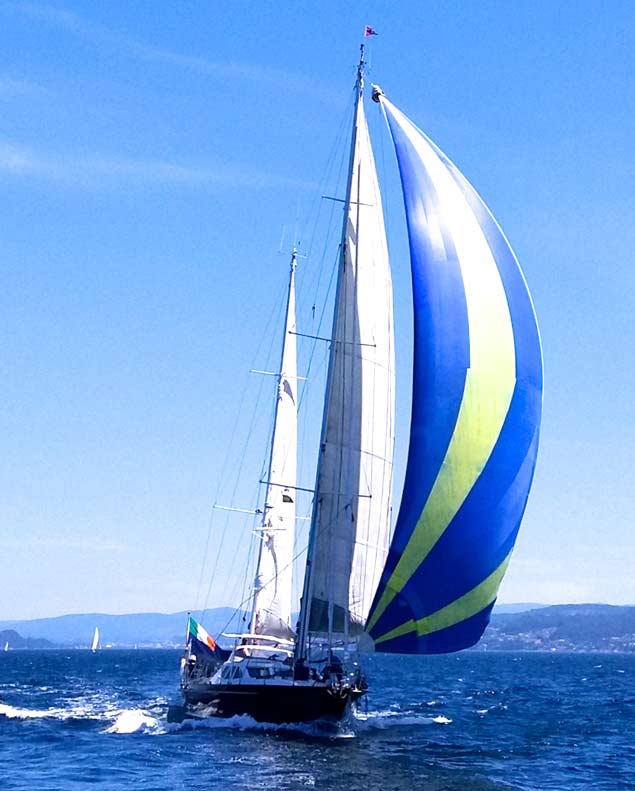 With more than sixty boats taking part, the Irish Cruising Club Rally in Northwest Spain was an outstanding success. This is Michael Holland’s 70ft 1993-built Dubois ketch Celtic Spirit – a veteran of Arctic and Antarctic cruising - making knots down the coast of Galicia. Photo: Trish Phelan
With more than sixty boats taking part, the Irish Cruising Club Rally in Northwest Spain was an outstanding success. This is Michael Holland’s 70ft 1993-built Dubois ketch Celtic Spirit – a veteran of Arctic and Antarctic cruising - making knots down the coast of Galicia. Photo: Trish Phelan
July: Irish Cruising Club Rally in Northwest Spain – seriously well organised, great fun to take part
July: Glandore Classics – fun, yet serious too
August: Rolex Fastnet Race from Cowes – serious
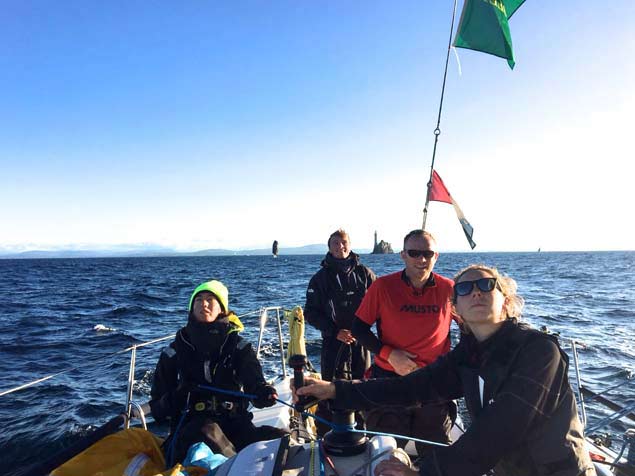 Fastnet Rock astern for Jedi, the Irish National Sailing School’s successful J/109, which won class IRC 3B in the Fastnet Race, and also the Roger Justice Trophy for the top-placed Sailing School boat. Jedi is one of the 15-plus class of hotly-raced J/109s in Dun Laoghaire, whose annual championship was won by the Kelly family’s Storm from Rush SC and Howth, while the most successful boat in other events was John Maybury’s Joker 2.
Fastnet Rock astern for Jedi, the Irish National Sailing School’s successful J/109, which won class IRC 3B in the Fastnet Race, and also the Roger Justice Trophy for the top-placed Sailing School boat. Jedi is one of the 15-plus class of hotly-raced J/109s in Dun Laoghaire, whose annual championship was won by the Kelly family’s Storm from Rush SC and Howth, while the most successful boat in other events was John Maybury’s Joker 2.
August: Calves Week from Schull – prides itself on being a neat balance between fun and “quite serious racing”, and succeeds in being so.
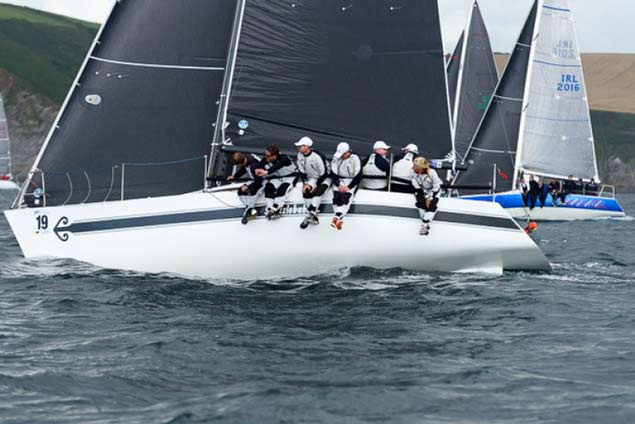 Everybody likes her, even if she beats them all. The characterful Swuzzlebubble racing to success in the Half Ton Classics at Kinsale. Photo: Robert Bateman
Everybody likes her, even if she beats them all. The characterful Swuzzlebubble racing to success in the Half Ton Classics at Kinsale. Photo: Robert Bateman
August: Half Ton World Classics at Kinsale: Supposedly serious, but in the ultimate lotus-eating venue and with such an extraordinary selection of boats, it couldn’t help but be fun. And everyone likes the slightly eccentric overall winner, the legendary Swuzzlebubble
August: Crinnui na mBad, Kinvara – traditional and fun
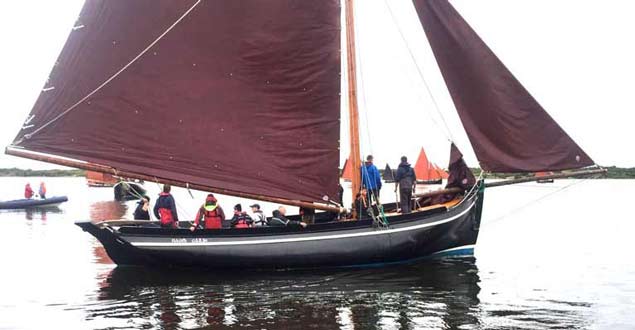 The annual Crinnui na mBad at Kinvara in August may not have been favoured with good weather, but it was as popular as ever. This is one of the winners, John Flaherty’s Galway hooker Naomh Cailin, going out to race. Photo: Pierce Purcell
The annual Crinnui na mBad at Kinvara in August may not have been favoured with good weather, but it was as popular as ever. This is one of the winners, John Flaherty’s Galway hooker Naomh Cailin, going out to race. Photo: Pierce Purcell
August: Laser Nationals Royal Cork YC – serious
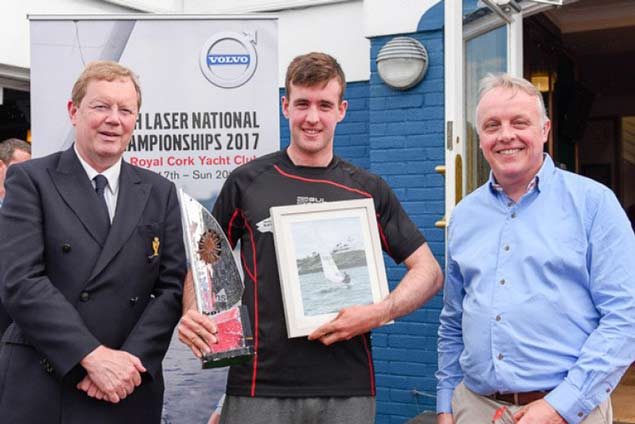 RCYC Admiral John Roche, 2017 National Champion Finn Lynch (NYC) and Mark Whisker of sponsors Volvo at the prize-giving for the Volvo Laser Nationals at Crosshaven. Photo: Robert Bateman
RCYC Admiral John Roche, 2017 National Champion Finn Lynch (NYC) and Mark Whisker of sponsors Volvo at the prize-giving for the Volvo Laser Nationals at Crosshaven. Photo: Robert Bateman
September: Autumn League at Howth – fun event, but run with such serious efficiency that they’d a full programme completed after six weekends despite losing two days of racing to the late season’s poor weather.
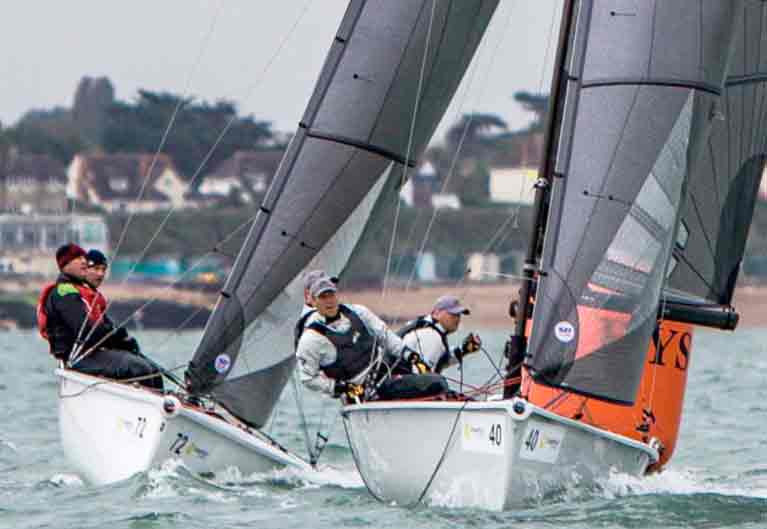 Royal St. George's Michael O'Connor, Davy Taylor and Ed Cook – SB20 'Corinthian' World Champions and Irish Champions
Royal St. George's Michael O'Connor, Davy Taylor and Ed Cook – SB20 'Corinthian' World Champions and Irish Champions
September: The SB 20 Nationals, incorporated into the first weekend of the Howth Autumn league as a three-day separate championship, had extra interest as it included recently-crowned SB 20 Corinthian World Champions Michael O’Connor, Davy Taylor and Edward Cook of Royal St George YC, who had won in the Worlds at Cowes. They added the Irish title to their 2017 trophy list.
October: Autumn League at Royal Cork - fun
October: Mini-Transat at La Rochelle – serious
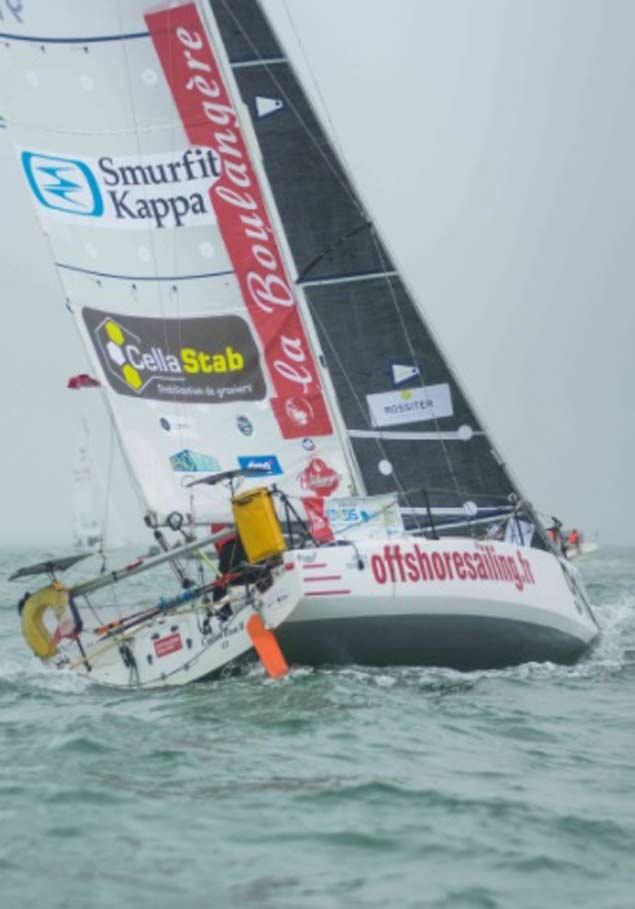 Ireland’s Tom Dolan in the first leg of the Mini-Transat 2017, 1,400 miles from La Rochelle to Las Palmas. He finished this stage 12th in a class of 55 boats The second Transatlantic stage starts on 1st November
Ireland’s Tom Dolan in the first leg of the Mini-Transat 2017, 1,400 miles from La Rochelle to Las Palmas. He finished this stage 12th in a class of 55 boats The second Transatlantic stage starts on 1st November
October: Junior All-Ireland at Schull – serious
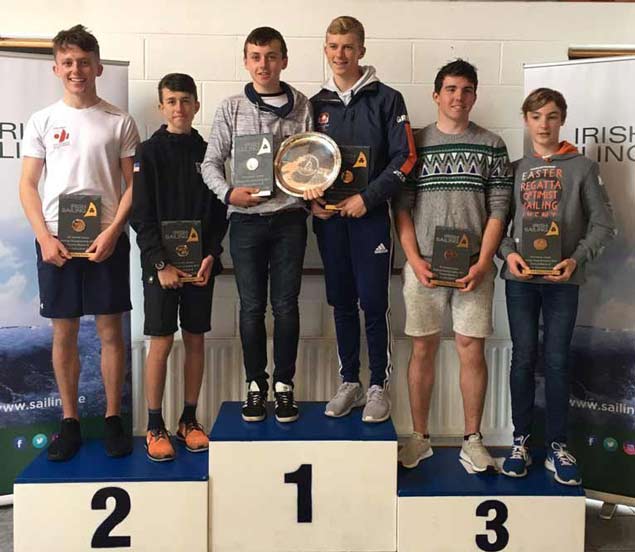 Junior All-Ireland winners on the podium. Kinsale YC’s champions Michael O'Suilleabhain and Michael Carroll, with second placed Rian Geraghty-McDonnell and Harry Durcan (RCYC) and Loghlen Rickard and Nathan Van Steenberge third. Photo: Robin Bateman
Junior All-Ireland winners on the podium. Kinsale YC’s champions Michael O'Suilleabhain and Michael Carroll, with second placed Rian Geraghty-McDonnell and Harry Durcan (RCYC) and Loghlen Rickard and Nathan Van Steenberge third. Photo: Robin Bateman
October: Senior All-Ireland Sailing Championship at Mullingar – serious and historic, as it is staged at one of the smallest, most rural clubs in the country, and raced in GP 14s.
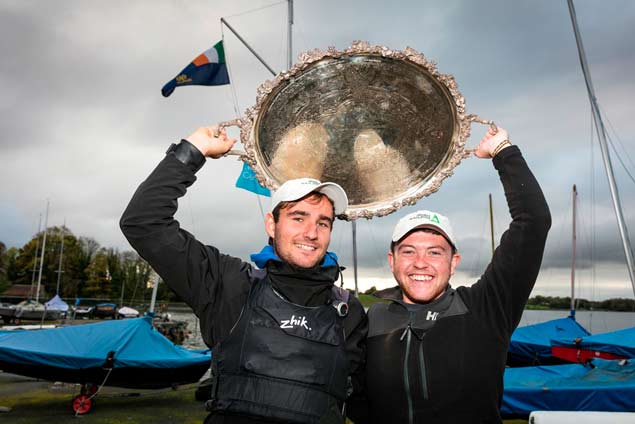 Fionn Lyden of Baltimore, All-Ireland Champion 2017, at Mullingar with the famous silver salver with crewmate Liam Manning of Schull. Photo: David Branigan/Sailing Ireland
Fionn Lyden of Baltimore, All-Ireland Champion 2017, at Mullingar with the famous silver salver with crewmate Liam Manning of Schull. Photo: David Branigan/Sailing Ireland
October: Student Yachting Worlds in Marseilles in France – serious. Ireland – a winner in times past –places fifth this time round.
October: Rolex Middle Sea Race from Malta – serious
October: Volvo Ocean Race from Alicante – serious
This fun/serious differentiation seems to have been supported by our wayward climate, which often managed to come up with good weather just when it was needed for the fun events, yet it achieved this in the midst of a generally very unsettled and often plain inclement summer.
The photos are all that is needed to show how this was so during 2017’s premier event, the Volvo Dun Laoghaire Regatta 2017 from July 6th to 9th. It wasn’t a sun-blasted regatta, but it wasn’t a wind-blasted one either – it was just a brief period of exceptionally pleasant warm weather with enough breeze for good racing , yet not too much wind to make it difficult to provide the in-harbour finishes which were introduced in special acknowledgement of the fact that they were also celebrating the Bicentenary of the massive work starting on the construction of this truly monumental and architecturally magnificent artificial port.
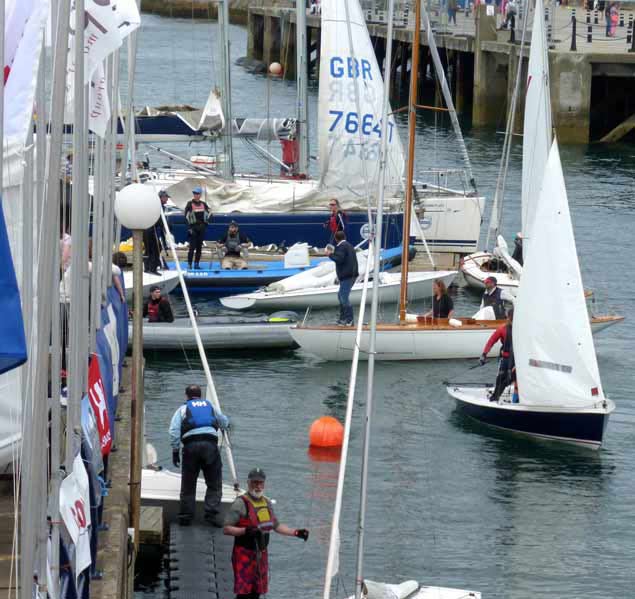 Piling them in – the good-humoured yet busy atmosphere off the National YC slipway after another day of racing in the Volvo Dun Laoghaire Regatta. Photo: W M Nixon
Piling them in – the good-humoured yet busy atmosphere off the National YC slipway after another day of racing in the Volvo Dun Laoghaire Regatta. Photo: W M Nixon
With 34 classes racing and boat numbers pushing towards the 500 mark, obviously it would have been totally inappropriate to try to include the ICRA Nats within it, as some have suggested. But even with such good conditions in its relaxed form, it could easily have got out of hand. However, with Organising Committee Chairman Tim Goodbody apparently yet always very quietly here, there and everywhere to ensure that all was running smoothly with a skillfully delegated team, it ran like clockwork to round out his two year stint in the top role with considerable style and success.
One noted visiting crew enthused that it was the best four days of sailing they’d ever had, and that was before they became aware that they’d won the ultimate trophy, the Kingstown 200 Cup, complete with a hundred guinea purse and a framed picture of the first regatta ever staged in what is now Dun Laoghaire, the Kingtown Regatta of 1828.
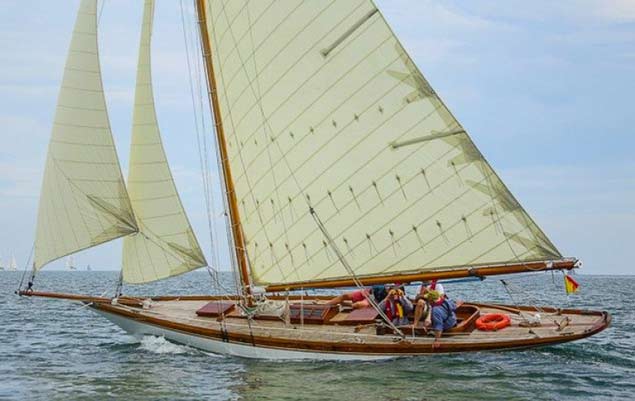 The sweetest boat in the fleet – Myfanwy from Wales - racing in the Volvo Dun Laoghaire Regatta. Photo: David O’Brien/Afloat.ie
The sweetest boat in the fleet – Myfanwy from Wales - racing in the Volvo Dun Laoghaire Regatta. Photo: David O’Brien/Afloat.ie
That was Rob Mason and his shipmates from Milford Haven with the classic 37ft Alexander Richardson-designed 1897-built gaff cutter Myfanwy, which Rob restored himself and sailed to Dun Laoghaire for the newly-introduced Classics Division, which was supposedly a one-off gesture to the Bicentenary.
But it worked so well that there’s talk of repeating it in 2019. Be that as it may, after the last race I was commiserating with the the Myfanwy team on their final placing, as I thought they’d sailed well enough to be comfortably on the podium, but Performance Echo decided others. Maybe they sailed too well. Yet far from being disappointed, they were on top of the world, and then when they went along to the huge prize-giving at the Royal St George, it was to hear to their complete surprise that the much-admired Myfanwy had been awarded the Kingstown 200 Cup and the prize purse and the historic picture……
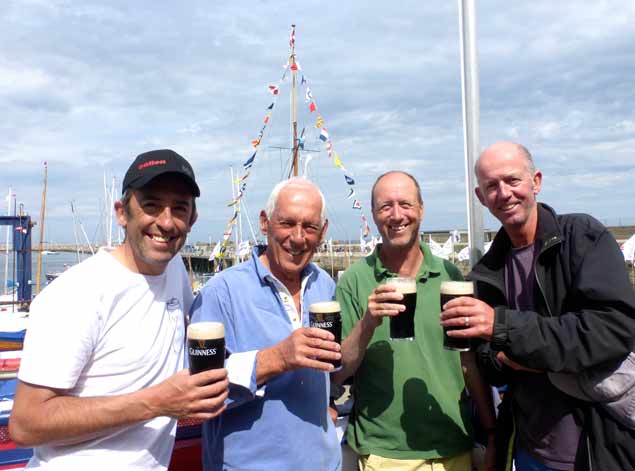 Before and after. Myfanwy’s crew celebrating “four days of the best sailing we’ve ever had” immediately after coming ashore at the conclusion of the final race in the Volvo Dun Laoghaire Regatta 2017. They are (left to right) Max Mason, his father Rob who restored Myfanwy, Andy Whitcher, and Gus Stott. The photo below shows them genuinely gobsmacked after finding they’d won the big trophy and its associated prizes. Photos W M Nixon and Gareth Craig/Fotosail
Before and after. Myfanwy’s crew celebrating “four days of the best sailing we’ve ever had” immediately after coming ashore at the conclusion of the final race in the Volvo Dun Laoghaire Regatta 2017. They are (left to right) Max Mason, his father Rob who restored Myfanwy, Andy Whitcher, and Gus Stott. The photo below shows them genuinely gobsmacked after finding they’d won the big trophy and its associated prizes. Photos W M Nixon and Gareth Craig/Fotosail
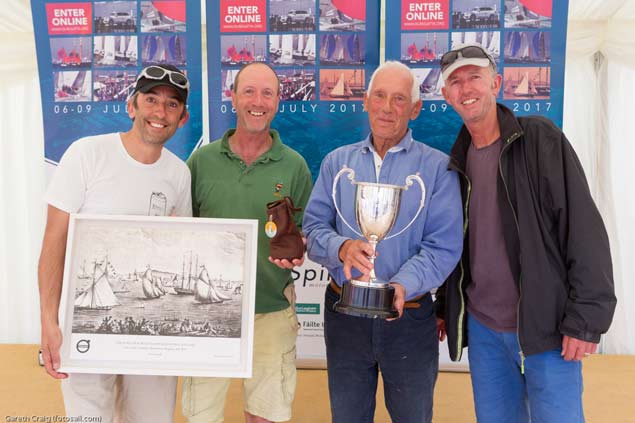
This classics success reflected a good year for the classic boats in Ireland, as six of the Howth Seventeens (1898) and a dozen of the Water Wags (1887 & 1900) made their way to the famous Sailing Week in the Morbihan in southern Brittany in May. Then at the end of July, the newest Howth 17s, Orla built in France for Ian Malcolm by the famous Skol ar Mor, arrived home, and in an epic effort in late August, in honour of Class President Hal Sisk, the continually reviving Water Wags managed their first turnout of more than thirty boats for their traditional Wednesday evening racing.
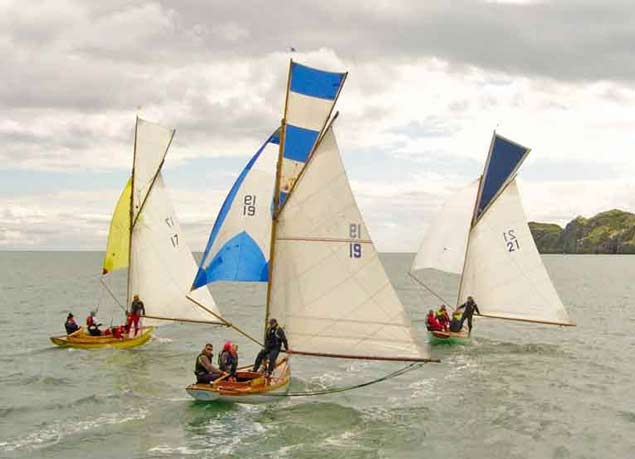 Howth Seventeens racing in their annual championship with Ireland’s Eye beyond – the new boat Orla (no 21) is on the right. Photo: Neil Murphy
Howth Seventeens racing in their annual championship with Ireland’s Eye beyond – the new boat Orla (no 21) is on the right. Photo: Neil Murphy
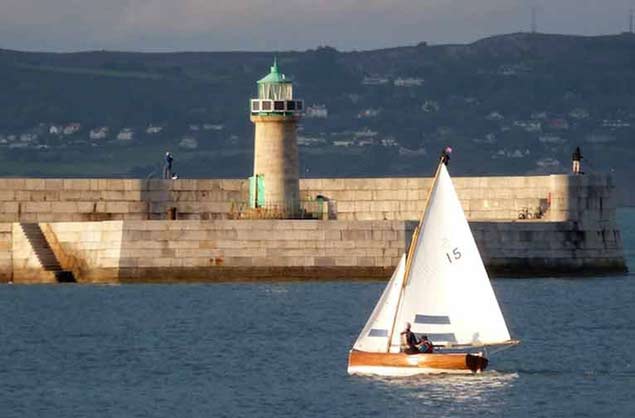 With a history going back to 1887, the Water Wags became an overnight success at the end of August when they finally managed a turnout of more than 30 boats. The clear winners were David & Sally MacFarlane with No 15 Mousmie, aged 107 years. Photo W M Nixon
With a history going back to 1887, the Water Wags became an overnight success at the end of August when they finally managed a turnout of more than 30 boats. The clear winners were David & Sally MacFarlane with No 15 Mousmie, aged 107 years. Photo W M Nixon
This has inevitably only been a skim across the events of 2017. An extraordinary season. Many hoped at the beginning of the year that it would see some relaxation after the intensity of the Olympic year, and while that may have been the overall mood, the achievements recorded above show that some sailors continued to take their own sailing very seriously indeed.
That is as it should be. But if I had to select a photo which captures the mood of 2017, the determination to make the best of it whatever the weather, then the Thomas Gautier image of Aoife Hopkins in devil-may-care mood, flying over a big sea off Douarnenez in Brittany on her way to winning the Laser Radial Under 21 European Championship, would undoubtedly be it. At that moment, Aoife was sailing for all of us.
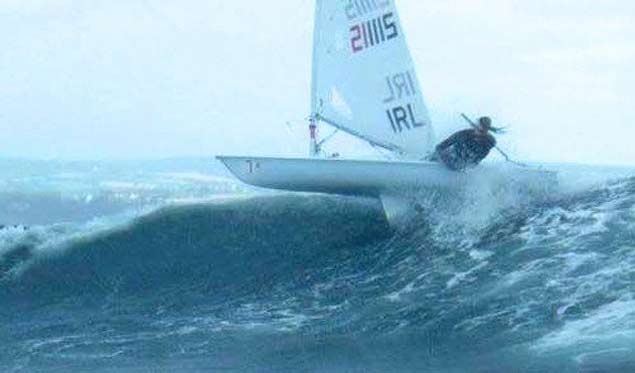 Sailing for all of us. Aoife Hopkins in devil-may-care style, on her way to winning the Laser Radial U-21 Euros at Douarnenez in July. Photo: Thomas Gautier
Sailing for all of us. Aoife Hopkins in devil-may-care style, on her way to winning the Laser Radial U-21 Euros at Douarnenez in July. Photo: Thomas Gautier
Historic Ketch Ilen’s Busy Workshop in Limerick Keeps the Baltimore Show on the Road
Many people have dropped by the Old Cornstore on the riverside at Oldcourt in West Cork to see work progressing on the restoration of the 1926 Conor O’Brien ketch Ilen writes WM Nixon. And naturally they’ll have the impression that they’re at the main scene of the action. After all, the 56ft vessel certainly looks the part - a complete ship, full of promise in her distinctive new colour scheme.
But as Gary MacMahon of the Ilen Boatbuilding School in Limerick points out, even with a hefty traditional vessel like Ilen, the finished hull with deck in place is only about 35% of the complete and fully commissioned vessel. And though the assembly of the various parts inevitably has to take place in Oldcourt with Liam Hegarty and his team, much of what you’re looking at on the Ilen today was actually built in the Ilen School’s efficient workshops in Limerick city.
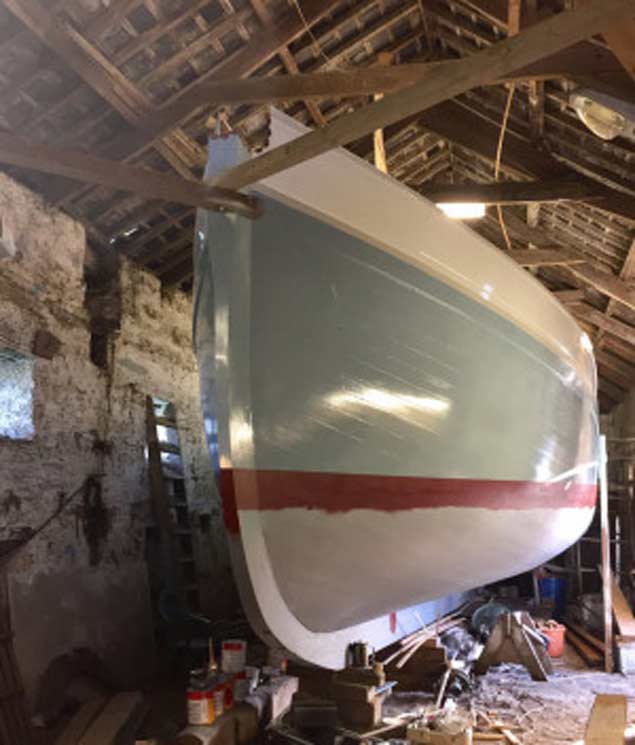 The Ilen herself in Oldcourt near Baltimore, newly painted and looking very well. Photo Ilen BS
The Ilen herself in Oldcourt near Baltimore, newly painted and looking very well. Photo Ilen BS
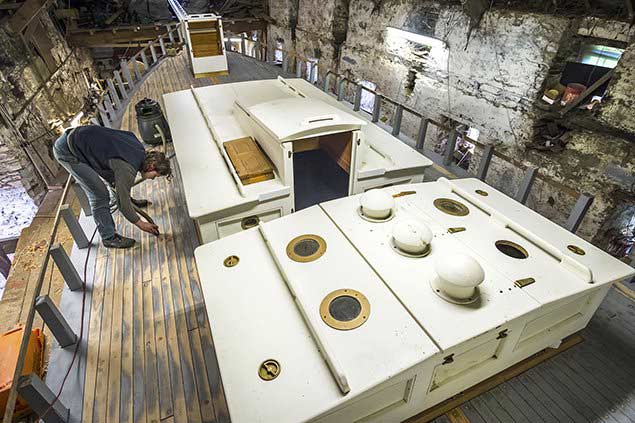 The new deckhouses, hatches etc on the Ilen were all made in Limerick. Photo Ilen BS
The new deckhouses, hatches etc on the Ilen were all made in Limerick. Photo Ilen BS
There, young people – indeed, people of all ages and from many backgrounds – are finding that working with wood, and creating parts for boats or building complete boats, is a profoundly interesting and fulfilling experience. In recent years, the Ilen School has turned out impressively authentic versions of the traditional Shannon gandelow, and in a completely different direction, sailing dinghies of the distinctive CityOne class to a very special design by the late Theo Rye.
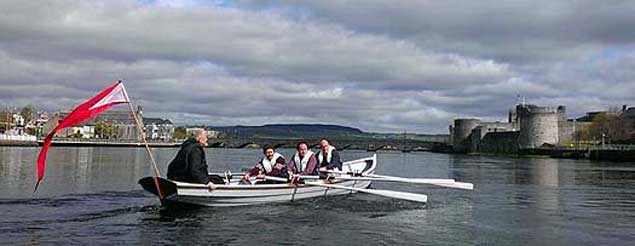 One of the Ilen Boatbuilding School’s traditional gandelows on the Shannon in Limerick, heading upriver towards King John’s Castle. Photo: Gary MacMahon
One of the Ilen Boatbuilding School’s traditional gandelows on the Shannon in Limerick, heading upriver towards King John’s Castle. Photo: Gary MacMahon
 It makes a change from the Shannon Estuary - the Ilen Boatbuilding School’s gandelows in Venice. Photos: Gary MacMahon
It makes a change from the Shannon Estuary - the Ilen Boatbuilding School’s gandelows in Venice. Photos: Gary MacMahon
These smaller craft have been imaginatively used by those who built them for various expeditions to events such as the Baltimore Woodenboat Festival and the Glandore Classics Regatta. And in 2014, the Gandelows somehow managed a remarkable double by taking part in the Thousandth Anniversary re-enactment of the Battle of Clontarf (wasn’t Brian Boru a Limerick man, after all?) and yet somehow also took in a Marine Festival in Venice, as it’s reckoned that the word “gandelow” originated from gondola, but mutated along the way.
Having taken such things and various other projects in their stride, the Ilen people in Limerick have enthusiastically lined up to build the deckhouses, hatchways, skylights, lignum vitae rigging deadeyes and many other items for Ilen herself. Each is an exquisite bit of marine joinerywork in its own right, and when fitted on the ship, they go so well with the overall concept that you’d be hard-pressed to guess that they were built many miles away, in the characterful city on Shannonside, rather than among the rolling green hills and woodland of West Cork.
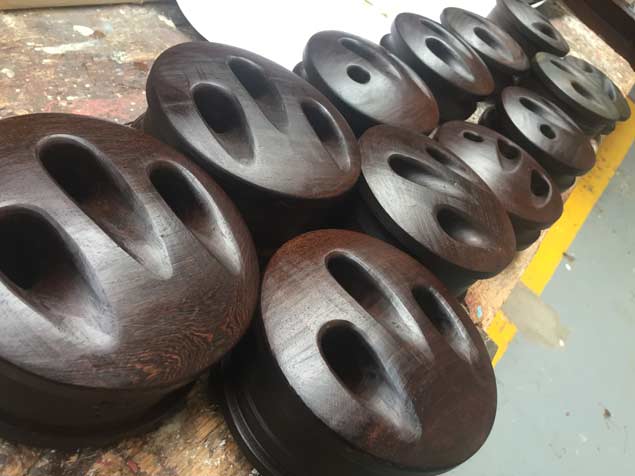 Deadeyes made in Limerick from rare lignum vitae – the word is that this very high density wood “was sourced from a former shipyard in Cork”. Photo: Gary MacMahon
Deadeyes made in Limerick from rare lignum vitae – the word is that this very high density wood “was sourced from a former shipyard in Cork”. Photo: Gary MacMahon
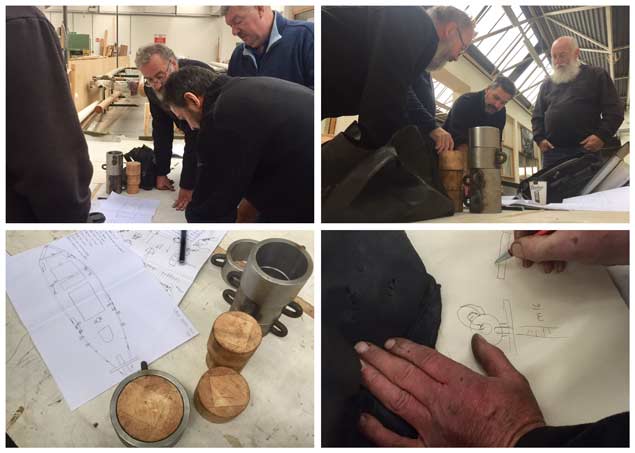 Group discussion in Limerick with Liam, Trevor, Pete and Robert to sort and assess items of rigging gear. Photos: Gary MacMahon
Group discussion in Limerick with Liam, Trevor, Pete and Robert to sort and assess items of rigging gear. Photos: Gary MacMahon
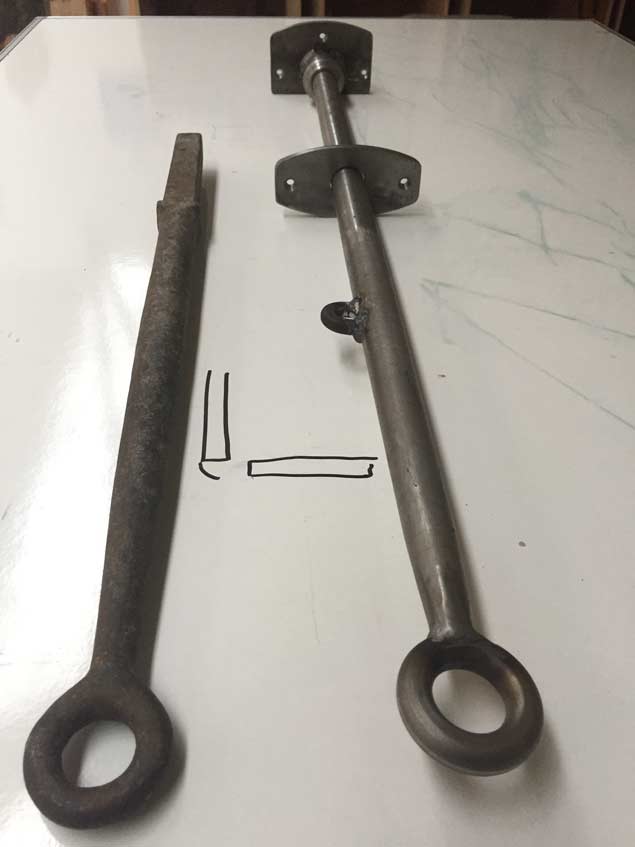 Modern safety requirements dictate that the original guard-rail stanchions (left) have to be replaced by longer ones (right) to provide one metre clearance. Photo: Gary MacMahon
Modern safety requirements dictate that the original guard-rail stanchions (left) have to be replaced by longer ones (right) to provide one metre clearance. Photo: Gary MacMahon
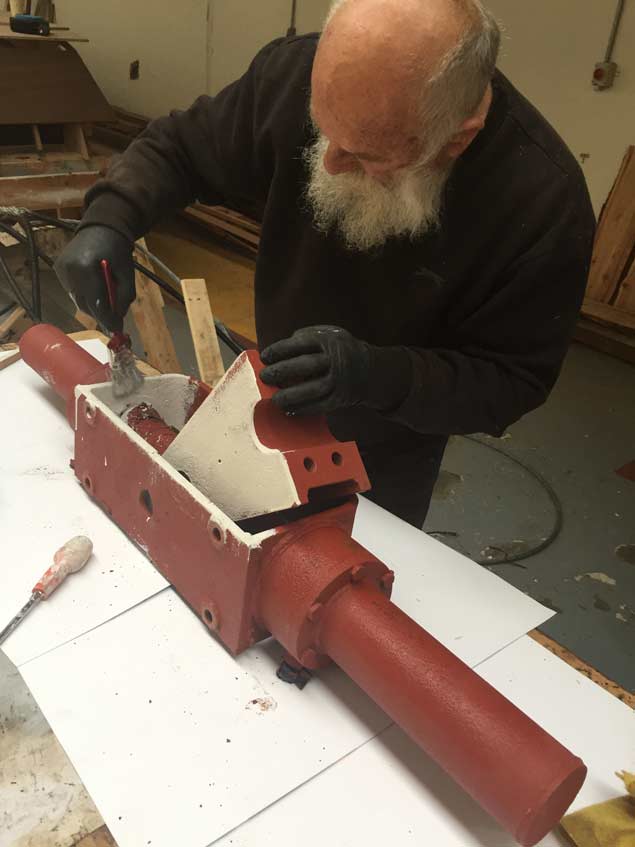 The hydraulic steering actuator is cleaned and serviced before being sent for pressure testing. Photo: Gary MacMahon
The hydraulic steering actuator is cleaned and serviced before being sent for pressure testing. Photo: Gary MacMahon
But such is the case, because for all his fondness for West Cork, Conor O’Brien’s spirit is in Foynes Island on the Shannon Estuary, and Limerick is his city, the city of the O’Briens since time immemorial. And recently, Limerick has been turning out the stanchions for the Ilen’s guard-rails, something which is well in line with the city’s engineering traditions. But most impressive of all is the final work on finishing the spars.
When Ilen was shipped back from the Falklands in 1998, some of her surviving spars were in a decidedly poor conditions. But the new Limerick-built replacements are robust works of art, with a natural functional beauty. It really will be a show on the road, and then some, when they’re taken on that winding journey from Limerick down to Baltimore.
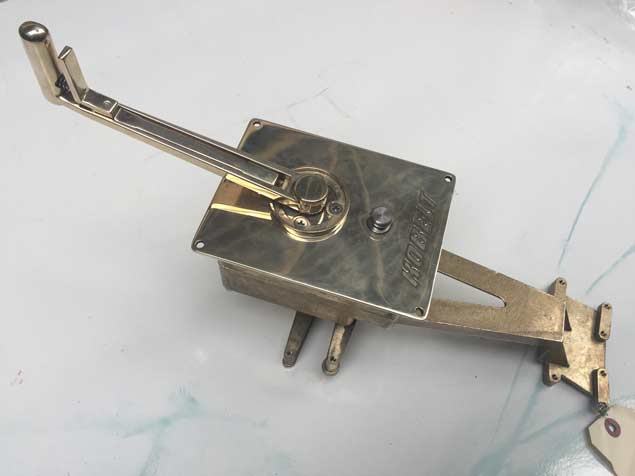 An authentic marine bronze Kobelt heavy duty engine control is sourced “by good fortune” – it cleans up a treat
An authentic marine bronze Kobelt heavy duty engine control is sourced “by good fortune” – it cleans up a treat
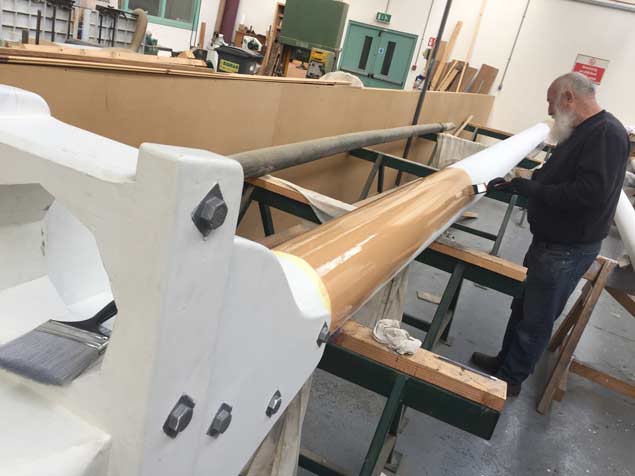 Finally getting there – Liam O’Donoghue gives Ilen’s new mainmast its finishing coats of paint – the special colour is “US Navy buff” Photo: Gary MacMahon
Finally getting there – Liam O’Donoghue gives Ilen’s new mainmast its finishing coats of paint – the special colour is “US Navy buff” Photo: Gary MacMahon
Restored Historic Ketch Ilen Starts to Get Authentic Rigging Through In-House Production
When the restoration project on the 1926-built 56ft Conor O’Brien/Tom Moynihan Falkland Islands Trading Ketch got under way at two locations – Liam Hegarty’s boat-building shed in the former Cornstore at Oldcourt near Baltimore, and the Ilen Boat-building School premises in Limerick – it was expected that final jobs such as making up the rigging and creating the sails would be contracted out to specialists writes W M Nixon.
But while the plan is still in place to have the sails made in traditional style by specialist sailmakers, Gary MacMahon and his team in the Ilen Boat-building School came to the realisation that they’d made so many international contacts over the years while the restoration has been under way that, if they could just get the right people’s schedules to harmonise, then they could learn how to make up the rigging in their own workshops as part of the broader training programme.
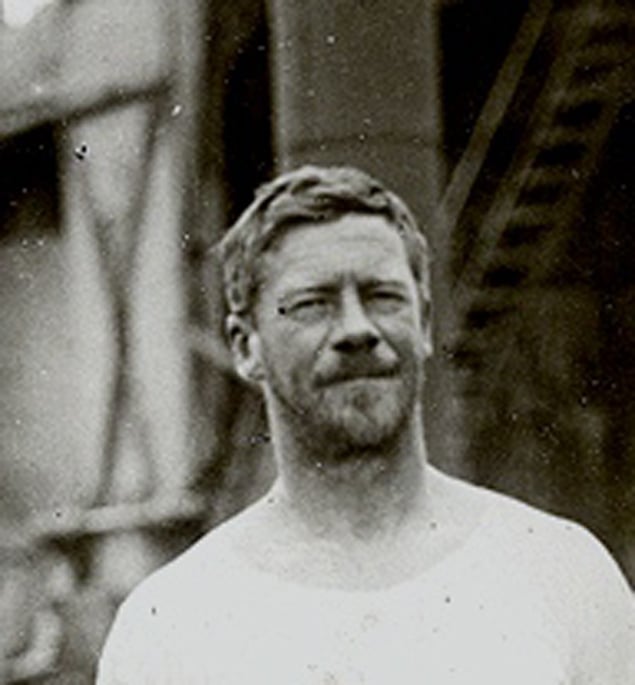 Conor O’Brien in 1926, when he delivered Ilen to the Falklands. He had received the order for the new ketch as a result of his visit to the Falkland Islands during his round the world voyage with the 42ft ketch Saoirse in 1923-25
Conor O’Brien in 1926, when he delivered Ilen to the Falklands. He had received the order for the new ketch as a result of his visit to the Falkland Islands during his round the world voyage with the 42ft ketch Saoirse in 1923-25
As a result, the Ilen Boat-building School became a hive of activity over the Bank Holiday Weekend and beyond, for that was the only time when noted heavy rigging experts Trevor Ross, who is originally from New Zealand, and Captain Piers Alvarez, master of the 45-metre barque-rigged tall ship Kaskelot, were both available to make their voluntary instructional contributions to the project.
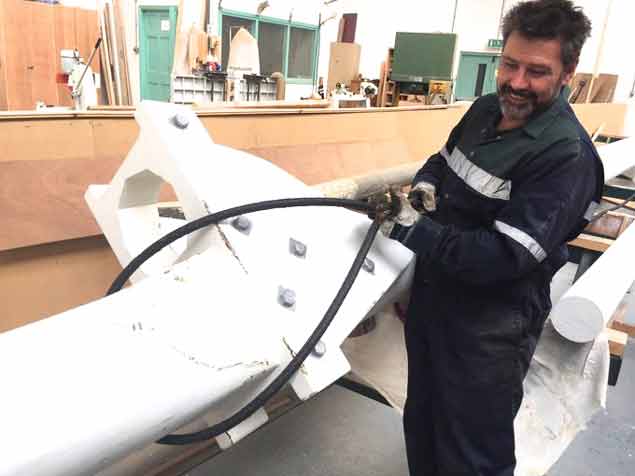 Trevor Ross with a new eye splice in the Ilen Boat-building School in Limerick. Photo: Gary MacMahon
Trevor Ross with a new eye splice in the Ilen Boat-building School in Limerick. Photo: Gary MacMahon
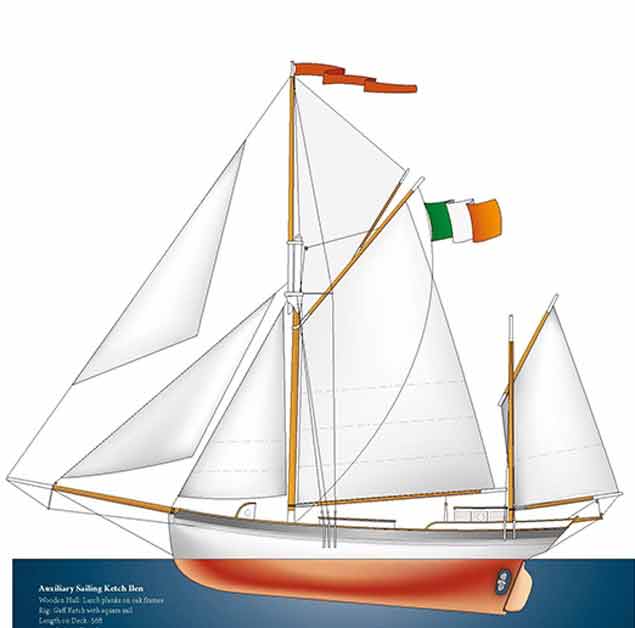 The re-creation of Ilen’s rig, as developed by Trevor Ross with the late Theo Rye
The re-creation of Ilen’s rig, as developed by Trevor Ross with the late Theo Rye
Trevor Ross was professionally at sea for ten years, during which time he became fascinated with traditional rigging techniques. Though he now works ashore, his interest in traditional rigging and sail training is greater than ever - so much so that he worked with the late Theo Rye in finalizing the design of Ilen’s rig to match the original from Conor O’Brien’s day, while ensuring that it is practical in modern terms both for requirements of efficiency and safety.
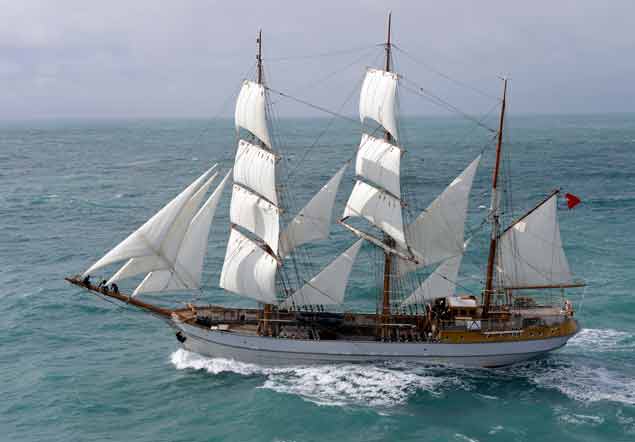 Captain Piers Alvarez’s current command is the 45-metre barque Kaskelot
Captain Piers Alvarez’s current command is the 45-metre barque Kaskelot
Piers Alvarez grew up in English cider country near the broad River Severn, but his personal horizons were far beyond apple growing. When he was 15, the captain of the famous square rigger Soren Larsen came to live in the village, which gave Piers’ father the opportunity to sign on his restless son as an Able Seaman at least for the duration of the school holidays, but the boy became hooked on the sea.
More than thirty years later, the love of seafaring and traditional ships is undimmed. Although Piers’ maritime career has also taken in tugs, superyachts and ice-classed research vessels, his current role in command of the Kaskelot perfectly chimes with his most passionate interests, and he has been fascinated by the entire Ilen project from an early stage.
So when the possibility arose of spending time in Limerick working along with his old shipmate Trevor Ross on the rigging for Ilen as a training project for the Ilen School’s intake, he readily gave up a week of his leave to teach the Ilen’s build team and future crew everything he knows, while moving a key part of the Ilen plan along the path of progress.
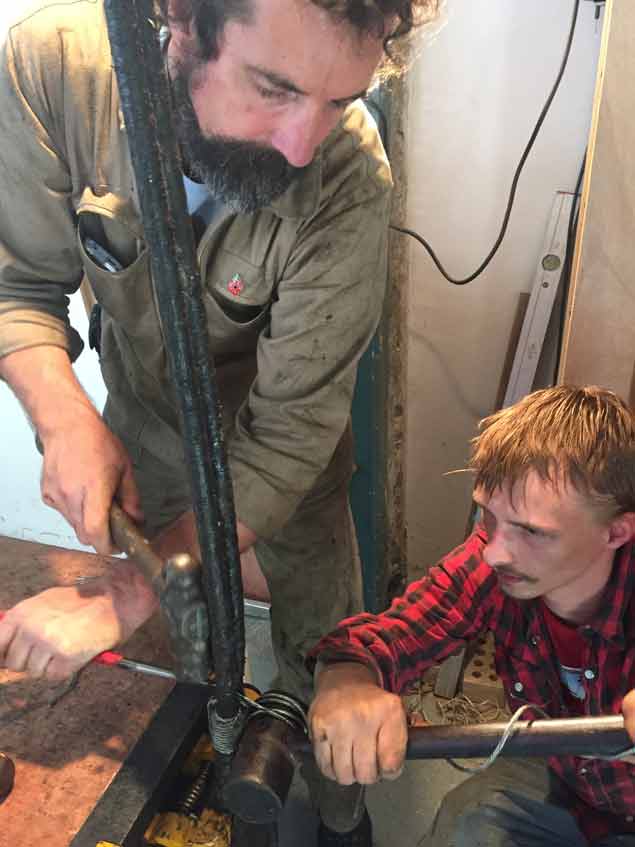 Piers Alvarez and trainee Elan Broadly busy with their work in Limerick
Piers Alvarez and trainee Elan Broadly busy with their work in Limerick
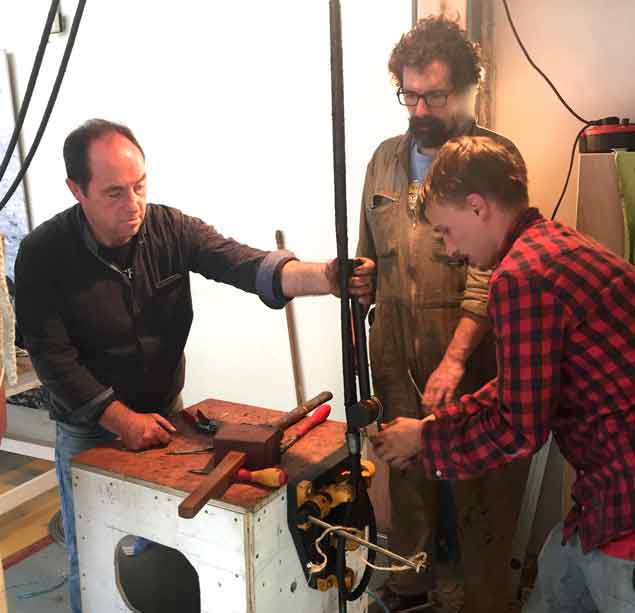 Ilen School Instructor James Madigan (left) with Piers Alvarez and Elan Broadly, immersed in their learning work while everyone else is on holiday. Photo: Gary MacMahon
Ilen School Instructor James Madigan (left) with Piers Alvarez and Elan Broadly, immersed in their learning work while everyone else is on holiday. Photo: Gary MacMahon
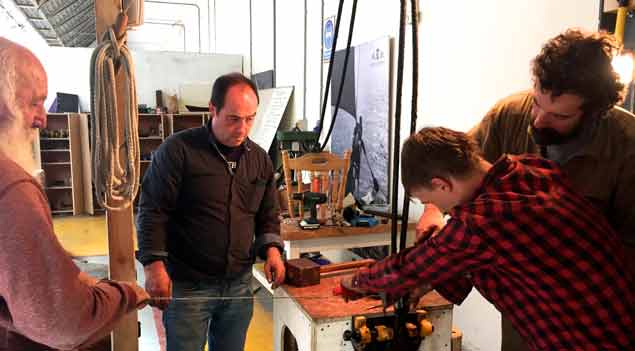 Team work. (Left to right) Liam O’Donoghue, James Madigan, and Elan Broadly on a steep learning curve with Piers Alvarez. Photo: Gary MacMahon
Team work. (Left to right) Liam O’Donoghue, James Madigan, and Elan Broadly on a steep learning curve with Piers Alvarez. Photo: Gary MacMahon
Modern amateur sailors, accustomed to today’s rigging where a terminal can be fitted in a seemingly-simple machine with the press of a button, can scarcely imagine the patient effort and skill which goes into making an eye splice in wire rigging which is of such a weight that, to most of us, it looks more like working with steel hawsers.
This is hard graft, but very rewarding in the result, and the satisfaction found in the effort expended. Much of it is done entirely by hand, but now and again that lethal multiple tool, the angle-grinder, will speed up a finishing job.
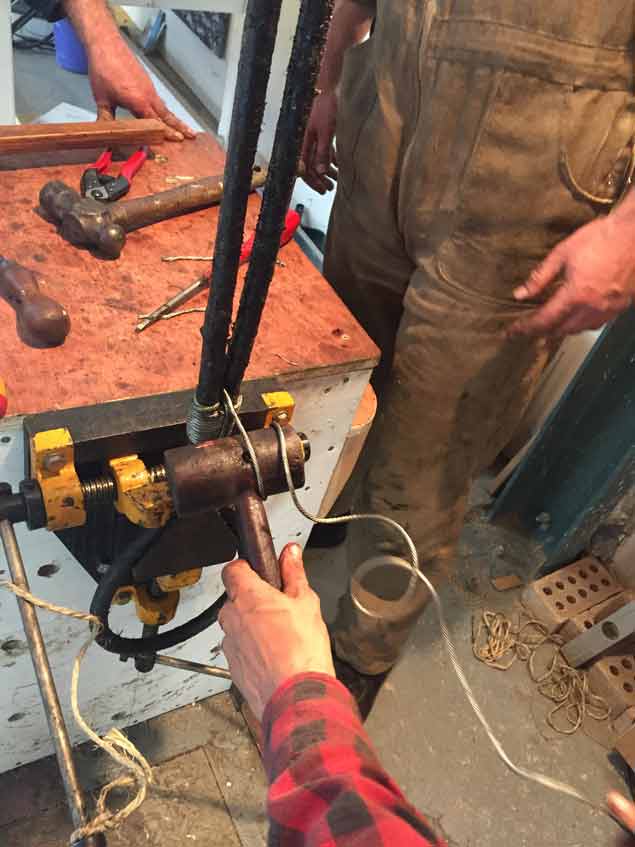 Some of the tools used in setting up traditional rigging are of very ancient origin…………….Photo: Gary MacMahon
Some of the tools used in setting up traditional rigging are of very ancient origin…………….Photo: Gary MacMahon
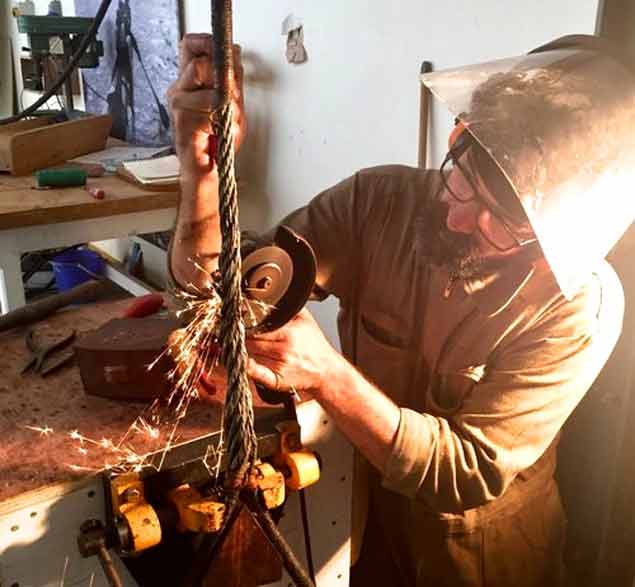 ….but inevitably an angle grinder will be used at some stage, and Piers Alvarez is ace with it. Photo: Gary MacMahon
….but inevitably an angle grinder will be used at some stage, and Piers Alvarez is ace with it. Photo: Gary MacMahon
When finished, the neatly parcelled eye-spliced shrouds will fit the re-shaped mast like a glove, while at the other end, the shrouds will be tensioned by traditional lanyards through dead-eyes which have been made in Limerick from tough greenheart timber. It’s a long way from a drum of raw steel wire and a still squared hounds area to be progressed into something which will function on the massive mast in smooth partnership, providing Ilen with her sailing power. And in Limerick over the holiday week, it provided an unusually satisfying way to learn something new and useful.
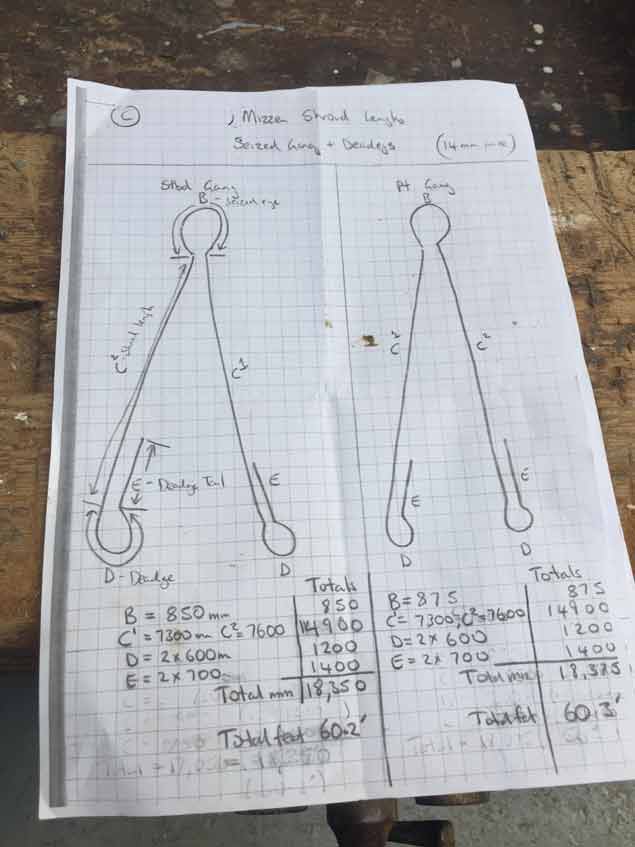 With the simplest of work drawings, an experienced rigger can turn a piece of hefty steel wire into a serviceable piece of rigging. Photo: Gary MacMahon
With the simplest of work drawings, an experienced rigger can turn a piece of hefty steel wire into a serviceable piece of rigging. Photo: Gary MacMahon
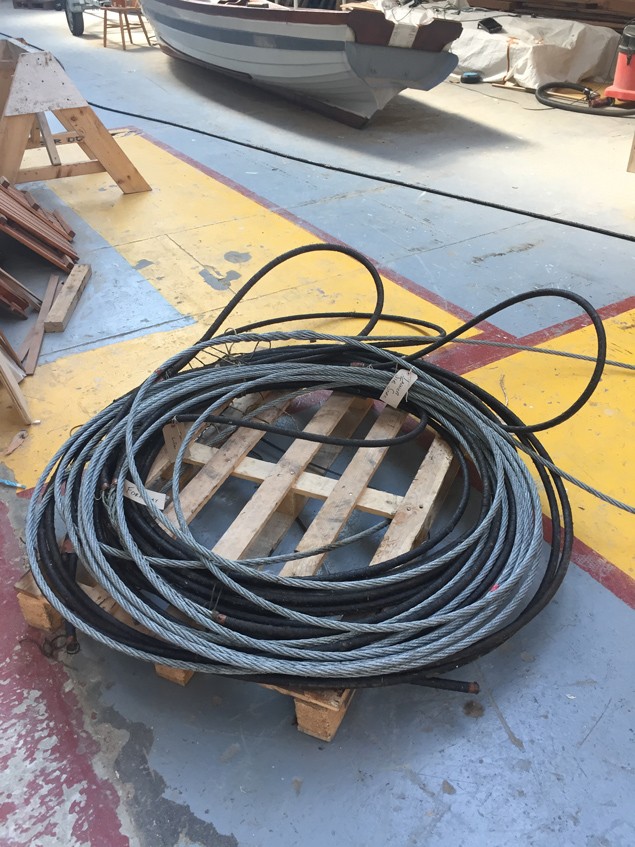 The thick steel wire in its raw state is a daunting sight. Photo: Gary MacMahon
The thick steel wire in its raw state is a daunting sight. Photo: Gary MacMahon
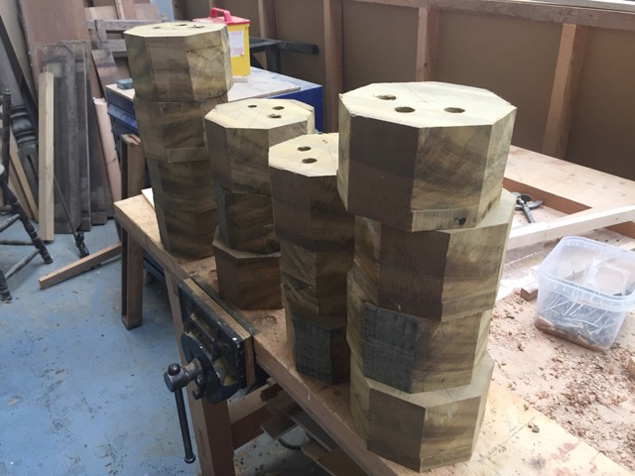 The lower ends of the shrouds will be attached to the chainplates by lanyards rove through deadeyes made from greenheart, seen here at an early stage of the shaping process in Limerick. Photo: Gary MacMahon
The lower ends of the shrouds will be attached to the chainplates by lanyards rove through deadeyes made from greenheart, seen here at an early stage of the shaping process in Limerick. Photo: Gary MacMahon
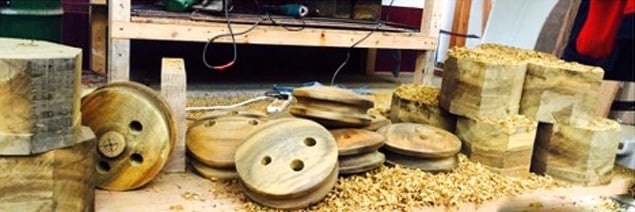 “Series production” of dead-eyes. Photo: Gary MacMahon
“Series production” of dead-eyes. Photo: Gary MacMahon
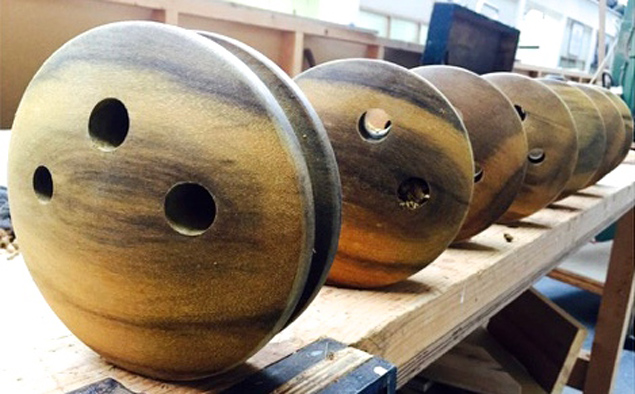 Dead-eyes at the final stage of their creation. All that remains to be done is to shape grooves to allow a fair downward lead for the lanyards. Photo: Gary MacMahon
Dead-eyes at the final stage of their creation. All that remains to be done is to shape grooves to allow a fair downward lead for the lanyards. Photo: Gary MacMahon
Classic Boat Variety at Glandore Regatta
If variety is the spice of life, then the 25th Anniversary Glandore Classics Regatta is currently staging the most vibrant and flavoursome boat show on the Irish coast writes W M Nixon.
Admittedly the mid-week routine, which will lead on to events like races to Castlehaven (or Castletownshend if you prefer), doesn’t have quite the same hectic pace as the opening weekend. But for connoisseurs of classic or traditional or even just plain odd boats, it’s a feast for eye, memory and analysis which has seen some vividly contrasting boats all united in at least one purpose.
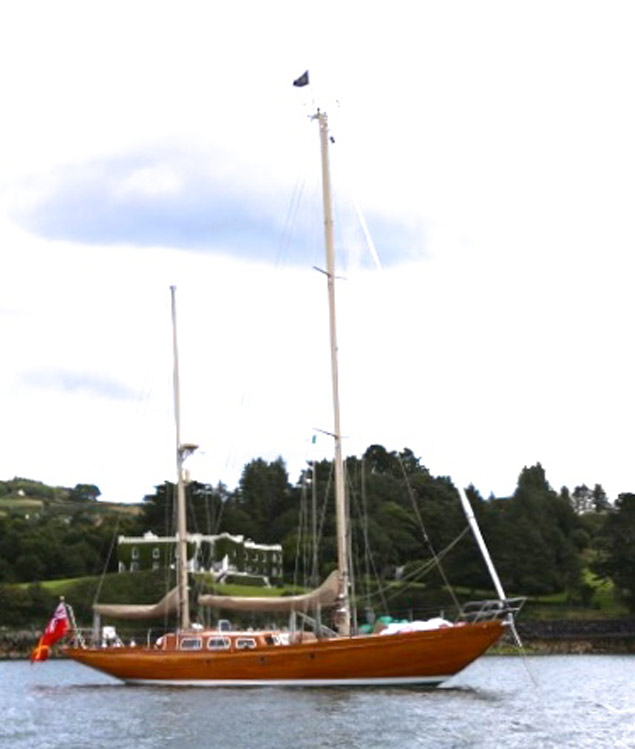 Flagship for style. The 1970 McGruer ketch Cuilaun at Glandore exemplifies the contemporary standard for classic yacht maintenance and presentation. Photo: Gary MacMahon
Flagship for style. The 1970 McGruer ketch Cuilaun at Glandore exemplifies the contemporary standard for classic yacht maintenance and presentation. Photo: Gary MacMahon
That purpose was to honour the memory and achievement of the late Theo Rye (1968-2016). He was taken from us all too soon last Autumn. But in his short life, his passion for yacht and boat design - its history and its future – was an inspiration for all who came in contact with him, and particularly those with whom he worked on a variety of projects which could range from the smallest of boats right up to the ultimate Fife restoration, the giant 23 Metre Cambria
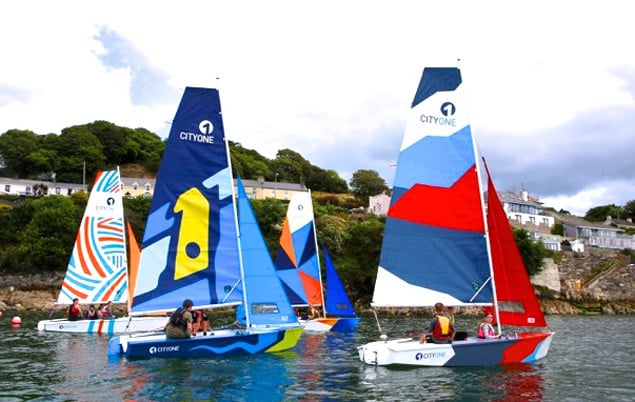 The CityOnes from Limerick cutting a dash with a difference at Glandore. It takes an effort to realize they were designed by Theo Rye, yet he could comfortably take such unusual challenges in his stride. Photo: Gary MacMahon
The CityOnes from Limerick cutting a dash with a difference at Glandore. It takes an effort to realize they were designed by Theo Rye, yet he could comfortably take such unusual challenges in his stride. Photo: Gary MacMahon
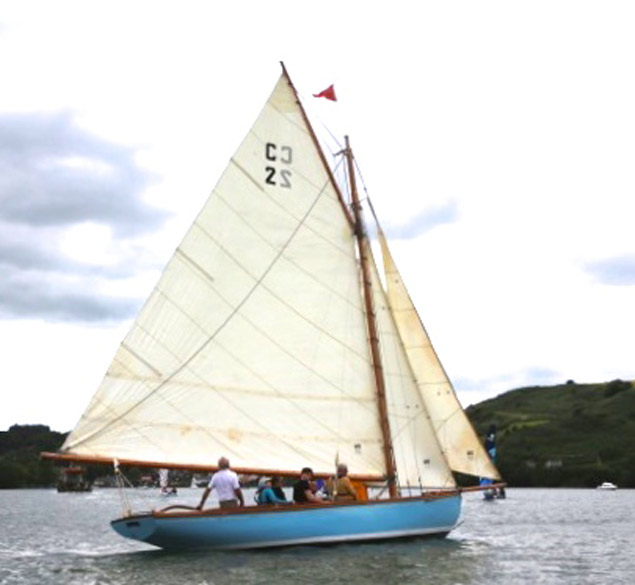 The Cork Harbour One Design Elsie (Patrick Dorgan) at Glandore. She was desined by William Fife in 1895-96. Photo: Gary MacMahon
The Cork Harbour One Design Elsie (Patrick Dorgan) at Glandore. She was desined by William Fife in 1895-96. Photo: Gary MacMahon
In Glandore, there are currently several boats which have benefitted from Theo’s expertise, or could do were it so wished. For instance, a regular at Glandore is the modernized Clyde 30 Brynoth, a Fife creation of 1905. If anyone had ever planned to bring Brynoth back to her original form, it would have been so reassuring to entrust the project to Theo’s encyclopaedic knowledge of the Fife design and build canon.
Yet the breadth of his influence and expertise is also seen in Hal Sisk’s eye-catching yet under-stated 63ft powercruiser Molly Ban, which is in Glandore to act as mothership to the owner’s Dublin Bay Water Wag. Molly Ban could be claimed to find inspiration from may sources, but she is such a unique combination of seagoing powerboat and classic dinghy mothership that we could reasonably argue she is sui generis, she’s just her own sweet self, and that’s all there is to it.
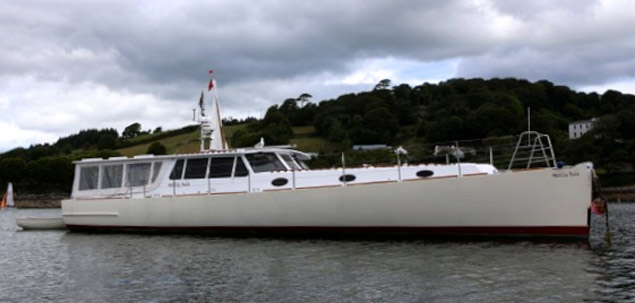 The 63ft Molly Ban is an elegant multi-purpose vessel whose large self-draining cockpit can be used as a “deck garage” for smaller classic craft. Photo: Gary MacMahon
The 63ft Molly Ban is an elegant multi-purpose vessel whose large self-draining cockpit can be used as a “deck garage” for smaller classic craft. Photo: Gary MacMahon
In addition to the owner’s advanced technical experience, Molly Ban saw the combined talent of Nigel Irens and Theo Rye put to work to create a very elegant and distinctive vessel so easily driven that, with a single 300hp Cummins diesel, she has a maximum loaded speed of 16 knots and makes an easily-reached 14 knots on 30 litres of fuel an hour. Yet if you throttle back to 10 knots – a tidy enough speed for most cruising – she burns only ten litres an hour.
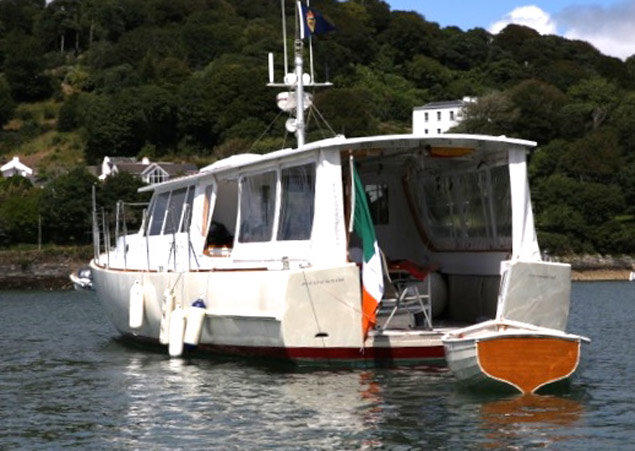 The stern view of Molly Ban gives a hint of the ingenuity of her design. The little clinker tender is based on a dinghy built for Hals Sisk’s grandfather in 1926. Photo: Gary MacMahon
The stern view of Molly Ban gives a hint of the ingenuity of her design. The little clinker tender is based on a dinghy built for Hals Sisk’s grandfather in 1926. Photo: Gary MacMahon
There’s a completeness to the Molly Ban concept which is a credit to the memory of Theo Rye. But equally, in looking at the presentation of all the top classics at Glandore, you realize that you’re looking at yachts which have been raised to a standard which Theo and others like him ensured was set, and then adhered to, and if anything improved over time.
His mind could also produce totally off-the-wall solutions to design challenges. But though we all know that it was Theo Rye who came up with the completely innovative design for the CityOne dinghies to be built by the Ilen Boatbuilding School in Limerick, nevertheless at Glandore it was still pause for thought to see them sharing the sea with the utterly classic Dublin Bay Water Wags, a design of 1900 which Theo Rye equally cherished.
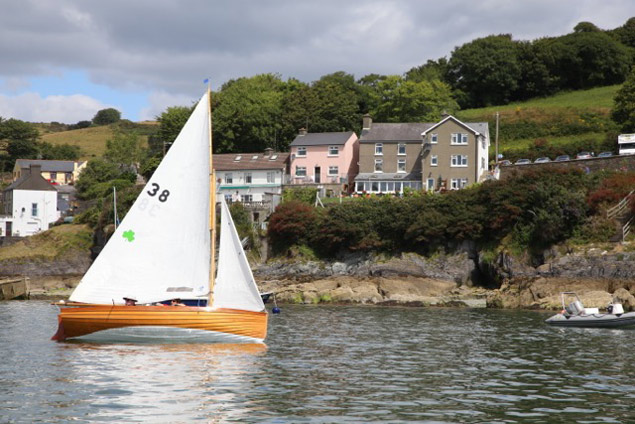 The timeless elegance of classic clinker construction. Guy Kilroy heels his modern-build Water Wag Swift to make the best of zephyrs at Glandore. Photo: Gary MacMahon
The timeless elegance of classic clinker construction. Guy Kilroy heels his modern-build Water Wag Swift to make the best of zephyrs at Glandore. Photo: Gary MacMahon
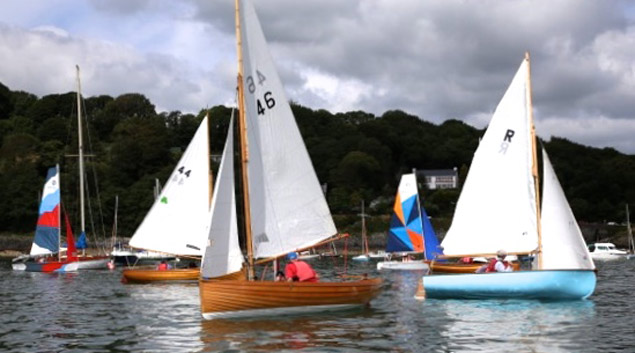 Mixing the fleets – Water Wags from Dublin Bay, CityOnes from Limerick, and a Rankin from Cork Harbour share the waters of Glandore. Photo: Gary MacMahon
Mixing the fleets – Water Wags from Dublin Bay, CityOnes from Limerick, and a Rankin from Cork Harbour share the waters of Glandore. Photo: Gary MacMahon
With four CityOne dinghies available in Glandore for an inter-area Theo Rye Memorial Series, Race Officer Donal Lynch was able to provide competition for a representative selection with crews from Limerick, the County Clare folk of Seol Sionna who had arrived in Glandore with their own distinctive Shannon Estuary hooker Sally O’Keeffe after a fine overnight passage from Kilrush, a West Cork crew with some involved in the restoration of the ketch Ilen at Oldcourt, and a Cork city team.
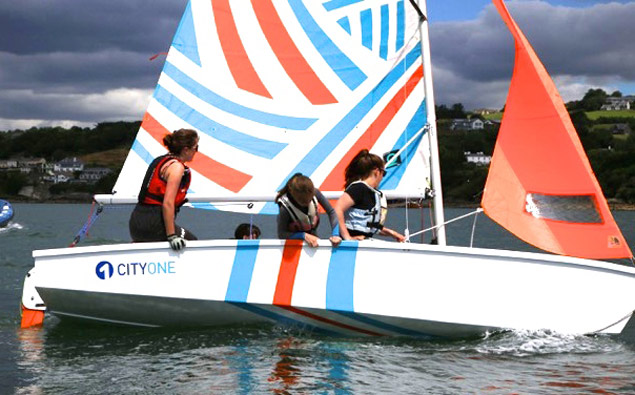 The Cork crew in the Inter-Area series for CityOnes were Nicola Cowhig (helm), Aoife & Muireann O’Donnell, and Gemma. Photo: Gary MacMahon
The Cork crew in the Inter-Area series for CityOnes were Nicola Cowhig (helm), Aoife & Muireann O’Donnell, and Gemma. Photo: Gary MacMahon
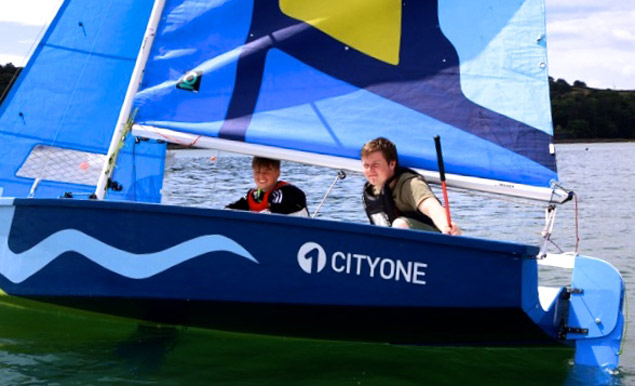 They may not look like they’re going anywere fast, but Limerick’s Donal Coffey (helm, right) and Sean McNulty won the Theo Rye Memorial Series for the CityOne dinghies. Photo: Gary MacMahon
They may not look like they’re going anywere fast, but Limerick’s Donal Coffey (helm, right) and Sean McNulty won the Theo Rye Memorial Series for the CityOne dinghies. Photo: Gary MacMahon
In the end, it was the Limerick duo of Donal Coffey (helm) crewed by Sean McNulty who won the weekend series overall, but really it was the way that the CityOne dinghies so ably fulfilled the role envisaged for them by Gary MacMahon of the Ilen School and Theo Rye which was the abiding memory.
As the photos reveal, Donal Lunch has had quite a challenge in setting races for all classes which will be manageable despite a shortage of wind, with further frustration early in the week as the underlying northerly airstream tended to negate the efforts of the warming summer days to create a sea breeze, but by week’s end we hope to get reports of improved sailing.
Meanwhile, a view of the classic style currently gracing the Glandore anchorage is more than enough to be going along with.
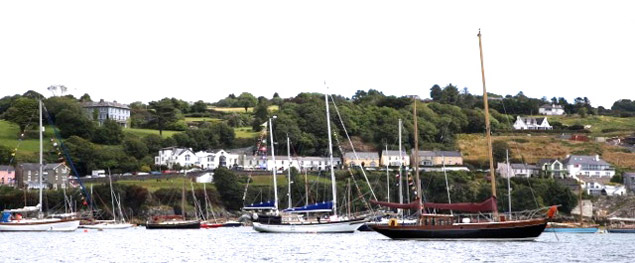 “Eclectic” would be the best word for the fleet at Glandore. Photo: Gary MacMahon
“Eclectic” would be the best word for the fleet at Glandore. Photo: Gary MacMahon
Sunshine Puts Classic Boats Back on Track at Cowes
The sun returned on day three of Panerai British Classic Boat Week where the fleets completed race five of the series, followed by the traditional Ladies Race. Not only had the sun reappeared, but the wind had moderated too and racing took place in a much more manageable, if rather shifty, northerly breeze of 10 to 15 knots. After the strong winds of the last two days the chance to shed oilskins, soak up the sun and enjoy the scenery was much enjoyed by everyone.
Class 3 continues to be the most closely fought of the regatta. Today Michael Briggs’ Mikado beat second placed Cereste, owned by Jonathan and Scilla Dyke, by over four minutes. Cereste in turn beat third place Laughing Gull, owned by Barney Sandeman, by just four seconds, so that in the overall standings Cereste leads Mikado by two points with Tim Yetman’s Suvretta in third.
Andrew Pearson’s Bojar finally managed to break the stranglehold of Giovanni Belgrano’s Whooper on Class 2, beating her into second place by a minute and twenty-four seconds. David Murrin’s Cetewayo came third by thirteen seconds. Whooper continues to lead Class 2 by a very comfortable fourteen-point margin, but the fight for second and third is a close one with Gildas Rostain’s Volonte on twenty points, Bojar on twenty-two points, Brian Smullen’s Cuilaun on twenty-nine and Cetewayo on thirty. Smullen's 55-foot McGruer ketch will also be sailing at Glandore Classic Boat Festival on July 23 in West Cork, read Afloat.ie's preview here.
Back ashore, Andrew Pearson talked through the race, “We had a really interesting day, with a complicated start across the Squadron line, and they all peeled off down the Island shore. We took a flyer to the other side, hoping we could set a kite, but by the time we got there, there wasn’t enough wind, so we were 8th or 9th at the first mark. From there we crawled our way back to 2nd on the water, 20 seconds behind Cetewayo, which gave us the win on handicap because we rate lower than she does. Whooper followed us in but we’d saved our time, so we’ve had a 1st, a 2nd and a 3rd in the last three races.
Asked what gave him the advantage over Whooper Andrew replied, “Three things: one, we’ve got a very large symmetric kite, and if we get that right we can fly it dead downwind and we’re as fast as anyone doing that. Secondly we had a tide break around the last mark. Finally, Whooper often has an enormous advantage over all of us with her drop keel so she can sail in much shallower water, but today’s course didn’t give them that advantage.”
Irvine Laidlaw’s Oui Fling took her fourth bullet of the regatta and now leads Class 1 by four points from Sean McMillan’s Flight of Ufford, who had finished second in the race. Michael Hough’s Chloe Giselle beat David Gryll’s Helen of Durgan in race five, but in the overall standings Helen of Durgan now lies third and Chloe Giselle fourth.
The battle between Richard Matthew’s Scorpio and Simon Payne’s Damian B continues to rage in Class 4. The lighter conditions worked in Scorpio’s favour and she beat Damian B by almost two minutes with John Mulcahy’s Estrella third. Overall Scorpio has regained the lead by three points from Damian B, with Estrella and Rufus Gilday’s Venya tied for third.
The Metre boats very much appreciated the lighter conditions and both fleets were back out in force. In the 6 Metres Robin Richardson and his team aboard St Kitts beat Fenton Burgin’s Sioma by just twenty-nine seconds with Tom Richardson’s Thistle third. In the overall standings Sioma’s lead has now been reduced to a single point from Thistle with St Kitts third.
In the 8 Metres it initially appeared that Murdoch McKillop’s Saskia had won race five from the Earl of Cork and Orrery and David Parson’s Athena with Christopher Courage’s Helen third. However, on returning ashore Saskia elected to retire following an on the water incident and so the race went to Athena with Helen second. Despite her retirement Saskia continues to lead the regatta, but her delta is reduced to a single point. Both Helen and Athena count ten points so it’s clear this class is going to go down to the wire as we go into the final two days of the regatta.
With the series racing complete for the day, it was the turn of the ladies to take the helm for the traditional Panerai British Classic Week Ladies’ Race. A building spring ebb meant the race committee kept the fleet close to Cowes for some furious short course racing. With midwife Rosie Parks on the helm, ably supported by Christine Belgrano, Mia Austen, Emma Cheesham, Giovanni Belgrano and Crawford, Whooper once again proved she’s a winner.
Speaking in the Panerai Lounge and clutching the Ladies Day Trophy, made by Isle of Wight based Sculptglass, Rosie paid tribute to her crew. “Today went really well! We had a brilliant start, my backing crew of Crawford and Gio made very, very good decisions and guided me around the race track and we got across the line first.”
This evening the participants are enjoying a BBQ and Crew Party at Cowes Corinthian Yacht Club. Tomorrow will feature the Long Inshore Race sponsored by Classic Boat and the rescheduled Open Boats Pontoon Party sponsored by Spirit Yachts and Classic Boat.
Les Wags de L’eau a la Semaine de Golfe de Morbihan
Over the next few days fourteen Water Wags will head by ferry to France to participate in one of the greatest classic boat regattas in Europe. As Afloat.ie reported previously, one thousand four hundred and forty two traditional workboats and recreational boats will head to Brittany from Britain, Ireland, Netherlands, Belgium, Switzerland, Austria, Czech Republic, Spain, and Japan.
Among the 19 yachts of the Irish contingent travelling to the celebration of traditional yachting are:
Waterwags: 9, Marie Louise (1927), 17, Coquette (1909), 31, Polly (1984), 32, Skee (1985), 33, Eva (1986), 34, Chloe (1991), 38, Swift (2001), 40, Swallow (2003), 41, Molllie (2005), 44, Scallywag (2009), 45, Mariposa (2015).
Howth 17 ft: Aura (1898), Deilginis (1905), Eileen (1908), Gladys (1907), Leila (1898), Silvermoon (1898).
Others: Anna Panna, a Mcmillan gaff cutter. Sylvana, Moody 46 and possibly the only boat which will sail to the event instead of being trailed.
What a celebration of Irish craftmanship it will be.
Classic Dublin Bay 24 Yacht to Return to Dun Laoghaire
The last time the Alfred Mylne-designed Dublin Bay 24s raced together in their home waters was Saturday, September 25th 2004 writes W M Nixon. Since then, the class has been through various traumas as projects for a group rebuild/restoration in France fell victim to the financial crisis.
However, the boats were kept in store, and two years ago a complete re-build programme for one of them, Periwinkle, was put into action at Skol ar Mor, the pioneering boat-building school in South Brittany run by Mike Newmeyer.
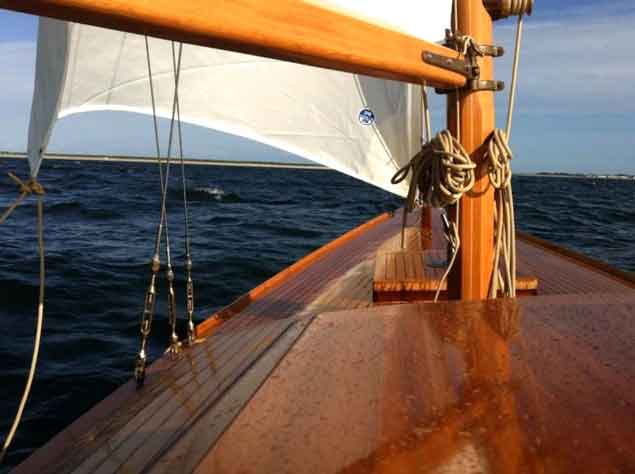 Sailing aboard the restored Periwinkle. The quality of the bronze fittings on the mast matches the high standard of the restoration. Photo Brian Mathews
Sailing aboard the restored Periwinkle. The quality of the bronze fittings on the mast matches the high standard of the restoration. Photo Brian Mathews
Perwiwinkle has turned all heads any time she goes sailing, but there’s no doubt she’d make most impression in an active class setting. As it is, for this year’s Morbihan Festival of Classic and Traditional Boats in the last full week of May, she’ll be sharing the waters of that noted inland sea with boats from home, as twelve Dublin Bay Water Wags and eight Howth Seventeens are being trailed, ferried, and trailed again to take part in one of the greatest gathering of character boats in the world.
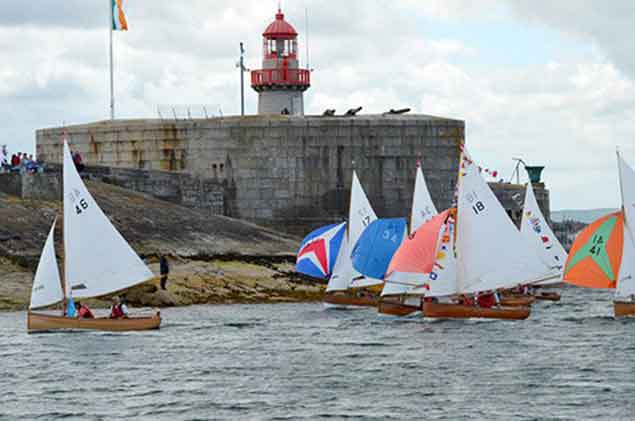 Water Wags in festive mode for their 125th Anniversary in 2012 at Dun Laoghaire Harbour mouth. In ten days time, 12 of them will be in France en route to the Morbihan Festival
Water Wags in festive mode for their 125th Anniversary in 2012 at Dun Laoghaire Harbour mouth. In ten days time, 12 of them will be in France en route to the Morbihan Festival
But while the Water Wags and the Howth Seventeen will be sailing in the enormous fleet, Periwinkle will be on static display afloat, alongside the Skol ar Mor booth at the boat show in the port of Vannes at the head of the Morbihan, though there is a possibility that renowned designer Francois Vivier will take her out for a sail. Happily, though, she’ll soon definitely be sailing – and she’ll be sailing to Dublin Bay.
Owners Chris Craig and David Espey are determined to get her back in time for the Classics Division in the Volvo Dun Laoghaire Regatta from 6th to 9th July, and will be sailing her up from Brittany with a target time of 1st July pencilled-in for arrival in Greystones. Their hope is that former DB24 sailors will then join them to sail on to Dun Laoghaire on Sunday July 2nd.
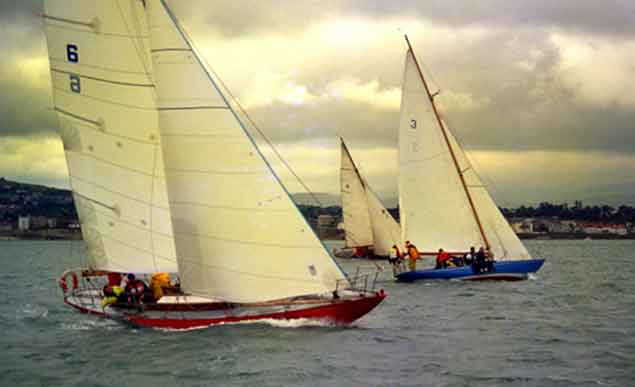 Class racing act. The Dublin Bay 24s in action at the Dun Laoghaire Woodenboat Regatta 1997. Photo: W M Nixon
Class racing act. The Dublin Bay 24s in action at the Dun Laoghaire Woodenboat Regatta 1997. Photo: W M Nixon
As for the rest of the DB24 fleet, their elegant yet tired hulls are finding new purpose in boat-building schools. In September, Adastra will go to Albaola Scholl in San Sebastian in northern Spain, Zephyra is being shipped across the Atlantic for the Apprentice Shop in Maine, and Arandora is to be completed in Les Atelier de L’Enfer in Douarnenez in Brittany. Mike Newmeyer is working on a plan for Euphanzel, and various proposals are being discussed regarding the future of Harmony and Fenestra.
It has been – and still is - a long and difficult journey. But the arrival of Periwinkle in Dublin Bay will surely be a very significant step
Minister Urged to Save Key Piece of Grand Canal Basin: Old Graving Docks
#SaveHistoricDocks - A Dublin docklands business group and waterways enthusiasts have called on Minister for Heritage Heather Humphreys to save a key piece of the Grand Canal basin’s Georgian architecture.
As The Irish Times writes The Inland Waterways Association of Ireland (IWAI) and the Docklands Business Forum (see related story) have initiated a petition this week which asks Ms Humphreys to ensure the basin’s lock gates and graving docks for ships are “restored, preserved and reused” for community gain.
The two groups believes Waterways Ireland wants to sell the graving docks site for further high rise development on the Liffey mouth.
The cross-Border agency is primarily responsible for the Grand Canal Basin and for the surrounding area where the three graving docks were constructed for vessel repair, while Nama also has a lease interest.
The graving docks and lock gates are as important to the heritage of the area as Battery Park is to New York, according to Docklands Business Forum’s chief executive Alan Robinson.
For more on this development click here.
Jehan Ashmore of Afloat adds that recently in an 'Aran Islands Snapshot' was featured the former ferry, Naomh Eanna which has been berthed in Grand Canal Dock for more than a quarter century.
The basin itself is considerably older having opened in 1796 for use of ships entering three docks to and from the River Liffey.
Only in recent years due to the threat of scrapping by Waterways Ireland that the historic Irish built ship was saved by campaigners. Among the reasons cited was due to possible sinking of the veteran vessel which led to the ship shifted from Charlotte Quay to a nearby disused graving dock dating to 1850's.
There have been plans by maritime heritge enthusiasts to restore the 1958 Liffey Dockyard built Naomh Eanna that ran for CIE between Galway City and Aran Islands. The project involved relocating to her former homeport in the mid-west city as a floating museum amongst other functions. The proposed visitor attraction was welcomed by Galway Port with a dedicated berth.
Grand Canal Basin was last used by commercial shipping until the 1960's. The three graving docks (the largest infilled) were used for repairs of small ships and canal barges.
WW1 Naval Gun Goes On Display at Dun Laoghaire's Maritime Museum
#WW1gun - A World War 1 gun retrieved from a wreck off Dalkey Island in Dublin Bay has recently gone on display at the National Maritime Museum in Dun Laoghaire, writes Jehan Ashmore.
The restored 6-pounder Hotchkiss gun is from the wreck of HMS Guide Me II. The exhibit was recently remounted in the grounds of the former Mariners Church on Haigh Terrace.
The HMS Guide Me II was built in 1907 as a Peterhead F.V. Drifter (i.e. a drift-net fishing boat) from the Scottish yard of Hall, Russell & Co in Aberdeen. In March 1915, she was hired by the Admiralty and converted into an anti-submarine coastal gunboat, with the addition of the six-pounder gun.
During a patrol she collided and depending on reports, the incident occured with an unnamed vessel or the nearby Muglins, a rocky islet east of Dalkey Island. The site of impact is clearly visible as a large hole is on the starboard side.
The Guide Me II grossed 100 tons and was approximately 26m long and 5.6m wide. The wreck lies 1.5 miles south-east of the Muglins and was rediscovered in 1990 by Ivan Tunsted who also rasied the gun from a depth of 33 metres.
For further details, they are available from INFORMAR by downloading PDF document here
In addition there’s also a 3D rendering (with a correct browser), from INFOMAR/Ulster University website click here
#HistoricBoats- A rare example of an Irish built ship dating more than a century and listed on the UK Historic Ships Registry, is to undergo a major refit for ‘sailing’ excursions in Scotland, writes Jehan Ashmore.
The historic ship Arctic Penguin of Glasgow, was launched in 1910 originally as lightship, Penguin for the Commissioners of Irish Lights at the Dublin Drydock Company. She is built of an iron hull on a steel frame and had a fixed lantern. During her Irish Lights days she served several stations, among them at Daunt Rock. On another posting, Afloat will have more on her lightship relief duties.
It is understood the 100ft Arctic Penguin of Glasgow, which since 2010 has remained in an idle state in Inveraray on Loch Fyne in Argyll, is to go to the Ardmaleish Boatbuilding yard on the Isle of Bute. Works at the Firth of Clyde facility are also understood to be costing in the region of £1.5m. The project is so to offer tourists sailing excursion charters of the Scottish Western Isles.
The vessel now 106 years old was first old by Irish Lights 50 years ago in 1966. The new owners converted the lightship into a youth adventure sail training vessel renamed Hallowe’en.
In 1982, she was resold for the purposes of cruising as the Arctic Penguin, and converted as a fore-and aft schooner. This involved the removal of the fixed lantern and to assist sailing canvas, she was fitted with a Kelvin engine.
In her most recent guise Arctic Penguin of Glasgow was a floating Maritime Museum moored alongside Inveraray Pier, where the three master has remained. It is at this stunning location in south-west Scotland, that I paid a visit to see this unique vessel of her Irish shipbuilding heritage.
So more than a century later, the former static role of this 400 tonnes tallship is to be given a new lease of life on the cruising grounds of the stunning Western Isles and lochs of Scotland. The wonderful highland peaks that surrounds Loch Fyne and Inveraray is a major beauty spot that draws tourists and which was an added bonus when tracking down the former lightship.
Located beside the town is Inveraray Castle, seat of the Duke of Argyle, where the grounds of the estate affords views of Inverarary Pier. Also berthed here is the Eilean Eisdeal, renamed the Vital Spark to highlight the old ‘puffers’ that were the backbone of sea-borne freight trade between the isles and the mainland.
In recent times, the vessels have shifted berths at the pier which also has an outer jetty. Both structures have been closed for some time to the public by Argyll and Bute Council.



























